By the 2nd century B.C. people were already talking about Kotor. Over the centuries, not only the fascination with this place grew bigger, but the town itself grew to become the biggest and most famous of Montenegro.
During the month I stayed in Kotor I spent several days getting lost in the narrow, cobblestone pedestrian streets of the Old Town. Inside the impressive walls encircling Old Town Kotor -a UNESCO World Heritage Site- I found lovely squares, stately residences, and several churches (some are now museums), each with unique things to see.
Towards the bottom of the post you’ll find a map that includes all the interesting spots I list here.
Disclosure: This post contains some affiliate links. If you make a purchase through those links I will earn a commission at no additional cost to you (zero, nada). To check the full disclaimer, click here.
This is what to do and see in Old Town Kotor
Table of Contents
The Kotor Gates
You’ve seen epic movies where warriors on horses triumphantly enter through big gates of walled medieval cities? You’ll experience something similar when you enter the Old Town of Kotor, minus the horses and the swords, and with way less fanfare.
As a totally enclosed site, you can only access it through three gates:
The Sea Gate (Main)

Since it’s located on the main road and close to the cruise ship port, the Sea Gate is the busiest. Two cannons (usually crowned by a cat or two) sit on both sides of a stone arch with a quote from Tito, the former Yugoslavia’s leader, reading: “We don’t want others’, we don’t give our own”, and a plaque marking the date his army freed Kotor from the Nazi occupation: November 21st, 1944.
The gate’s history goes way back to the 16th century. Inside the gate there’s some sort of an altar with three stone reliefs from the Venetian period: Madonna and Child sitting on a throne in the centre, St. Tryphon -patron of Kotor- on the left, and St. Bernard on the right.
You’ll also have a good appreciation of how thick the wall is in this section.


The Sea Gate will drop you right at the Square of Arms (Trg od Oružja), the biggest in Kotor. The most prominent structure here is the Clock Tower, built in 1602.
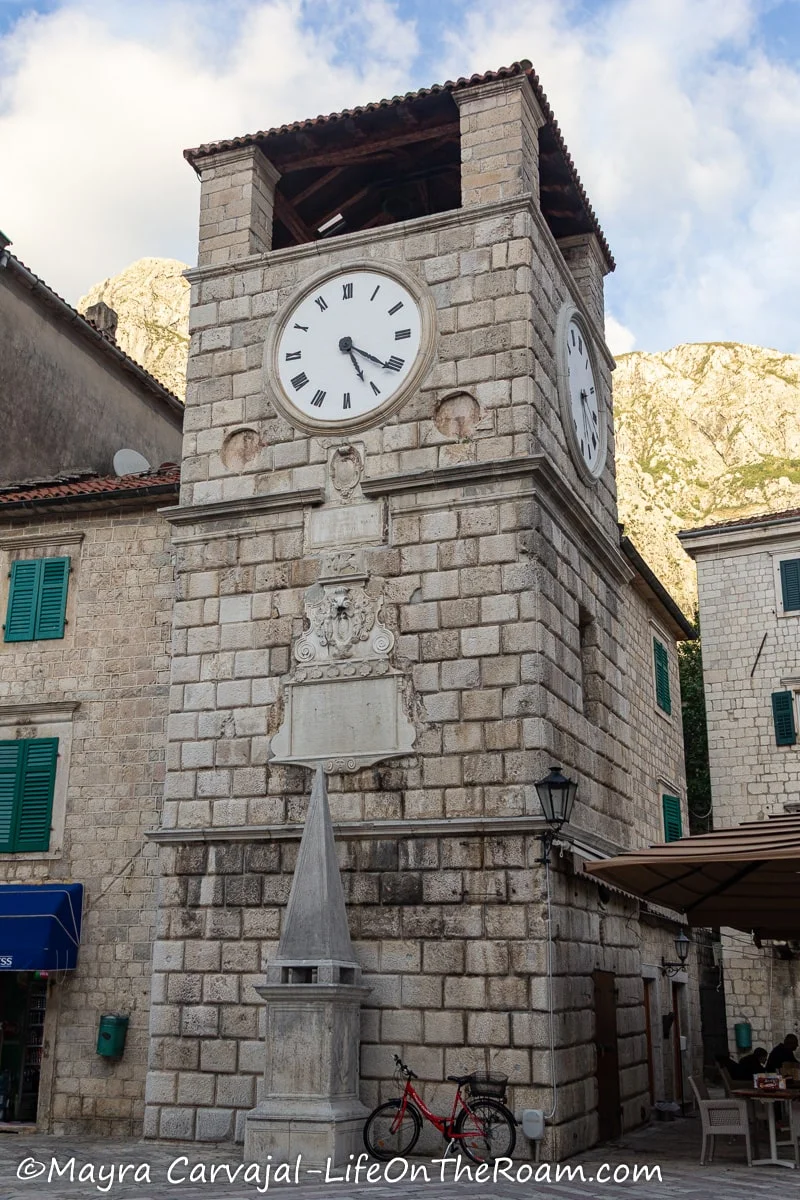
The River Gate (North Gate)
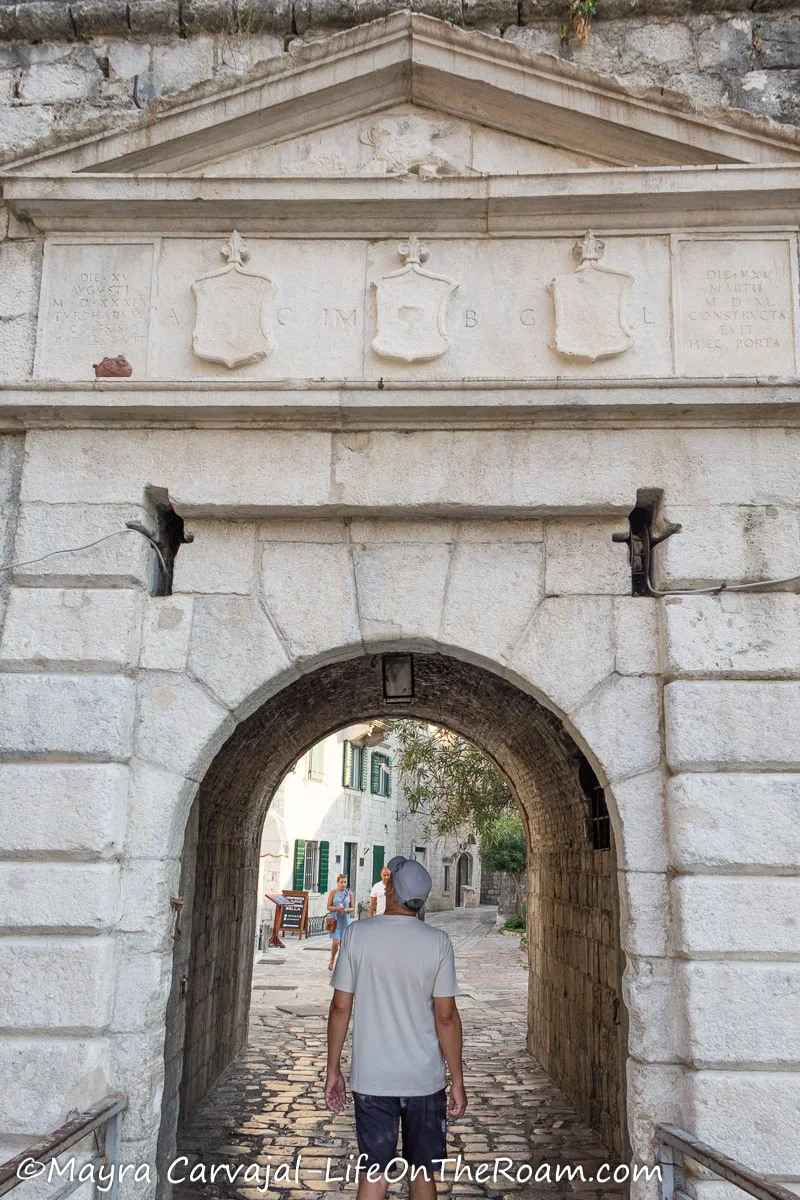
This entrance is more scenic not because of the gate per se, but because of its proximity to the mountain. You enter via a bridge over the Škurda River from where you can have a good view of the Kotor wall going up the hill. It’s quite a sight at night when the wall is illuminated.
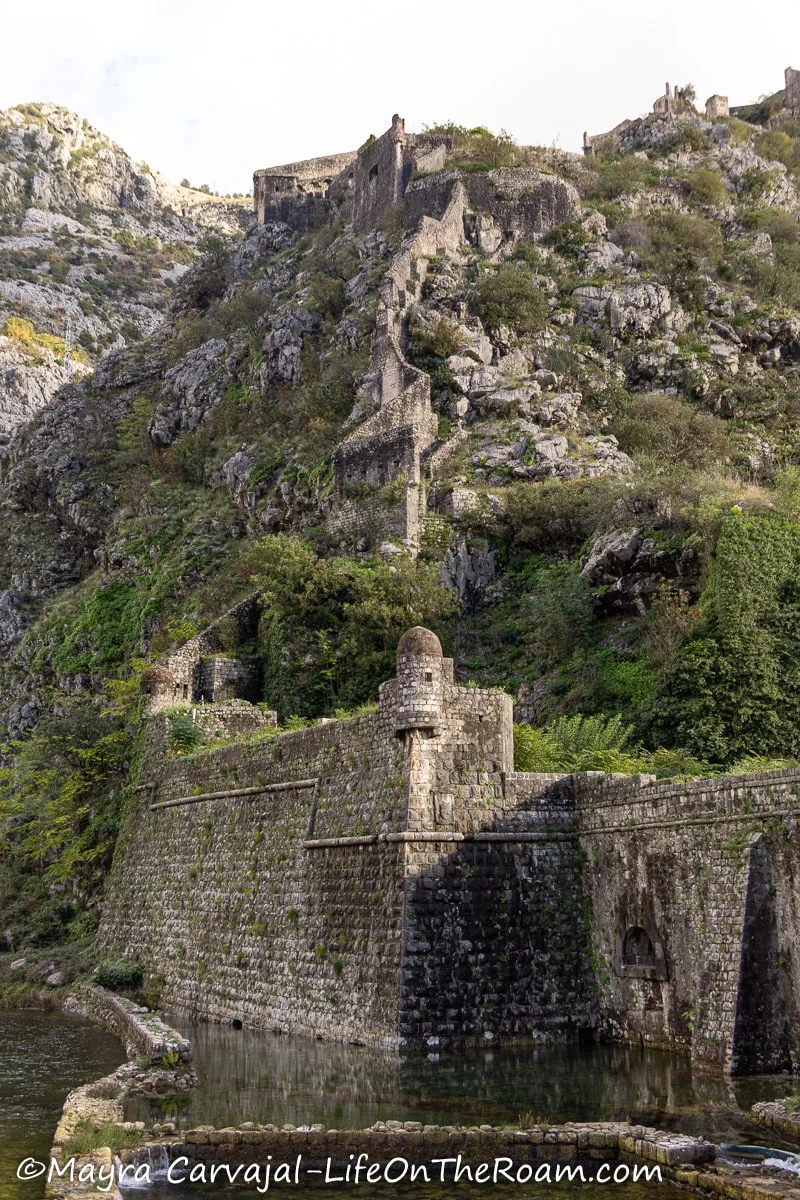

This is the closest gate to one of the two trailheads to the Kotor Fortress hike.
The Gurdić Gate (South Gate)

This gate also uses a bridge, but in this case it’s right against the mountain. The nicest detail about this one is that you can still see the drawbridge section. This is another spot where you can see up close the wall going up the hill, especially at night.
Hike the Kotor City Walls
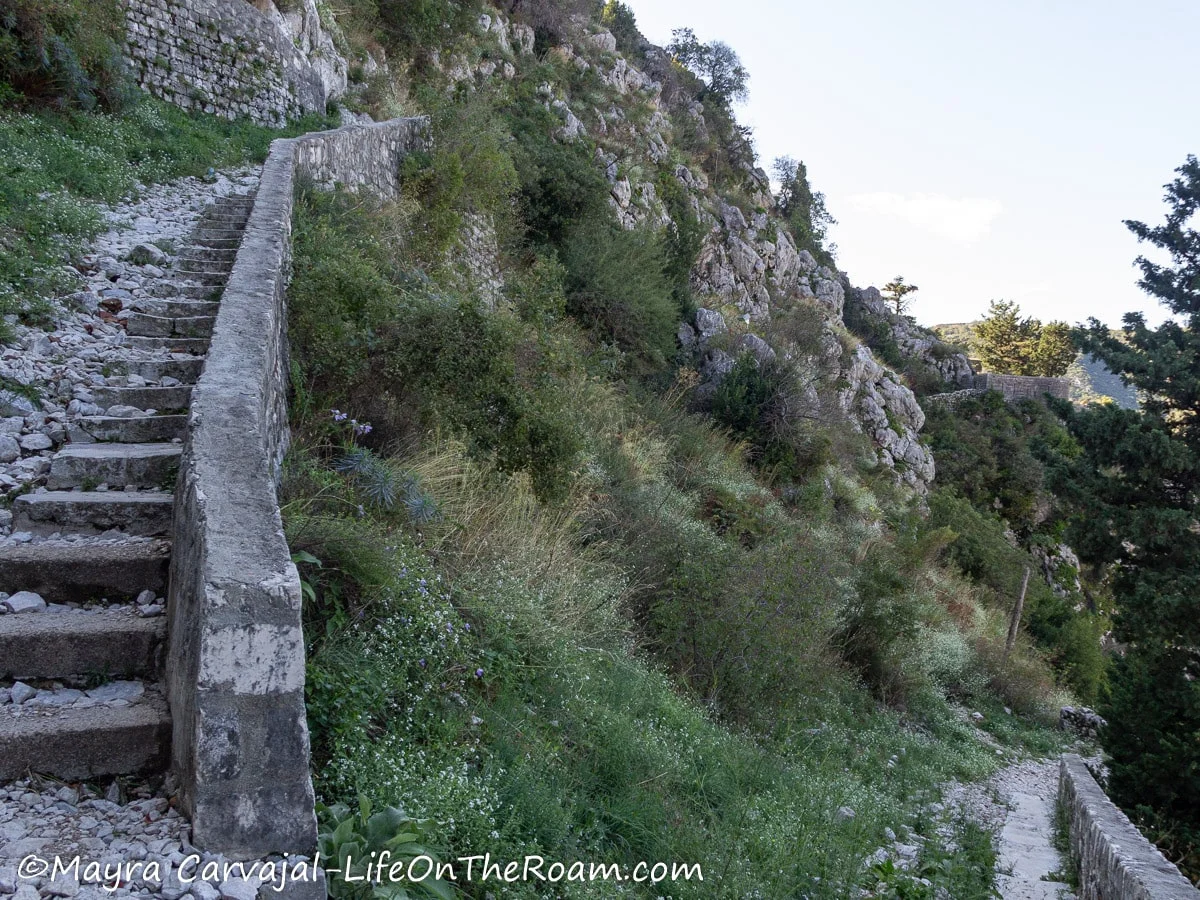
One of the most impressive things about Old Town Kotor is the defensive system built in the middle ages in the form of an imposing wall with bastions, towers, and all the frills.
Even more impressive is that the nearly five kilometres of wall (3 miles) goes several hundred feet up in the mountain to include a fortress and a church inside the city enclosure.
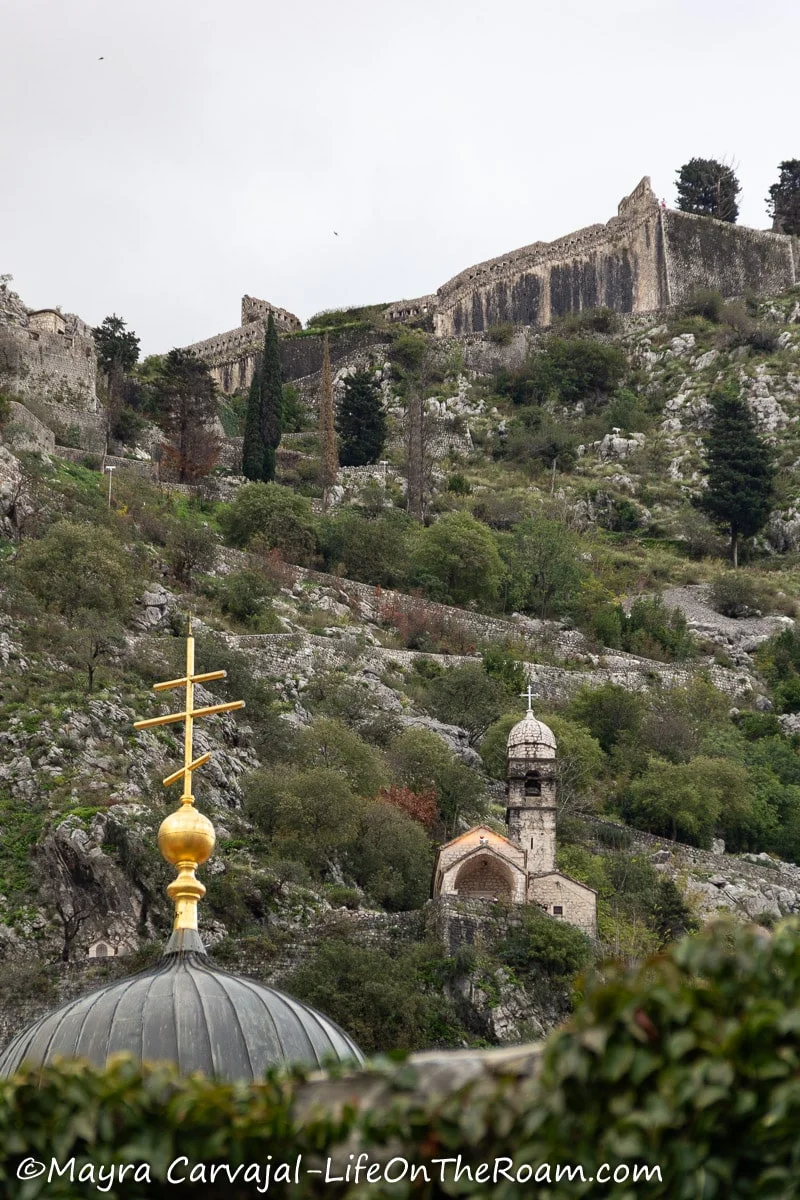
The Kotor Fortress hiking trail will take you up St. John’s Hill for a closer look of the upper section of the wall and to enjoy an awesome panoramic view of the Bay of Kotor and the nearby towns.
It’s a steep hike on old steps, so you must be prepared.

Learn what you need to know about this hike and many useful tips on my blog post about the Kotor Fortress Hike.
St. Tryphon’s Cathedral and Sacral Art Museum
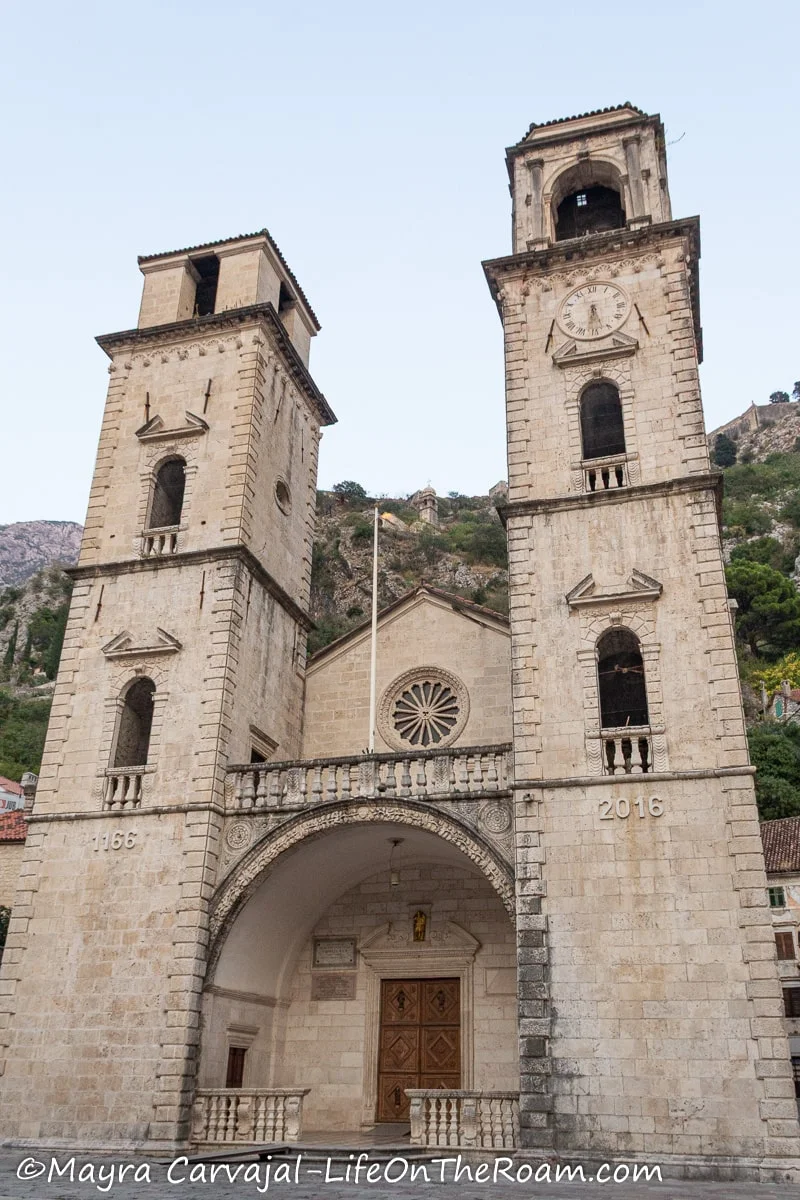
This Romanesque-style basilica-cathedral dedicated to the patron saint of Kotor stands on the remains of the first church in town, built in 809 during the establishment of the Early Christian church.
The construction you’ll see now started in 1124 and ended in 1166, with a distinctive wide arched portico and a big terrace above overlooking St. Tryphon’s Square.
Several renovations have taken place between 1166 and now, including a reconstruction after a 17th century earthquake that brought new Baroque-style towers and a peculiar entrance, and another one after the 1979 earthquake.
Walk to the side of the cathedral to see the nice tympanum and frame around the side door and to the back (on Ulica 2) to delight in this beautiful window with gothic-style elements.
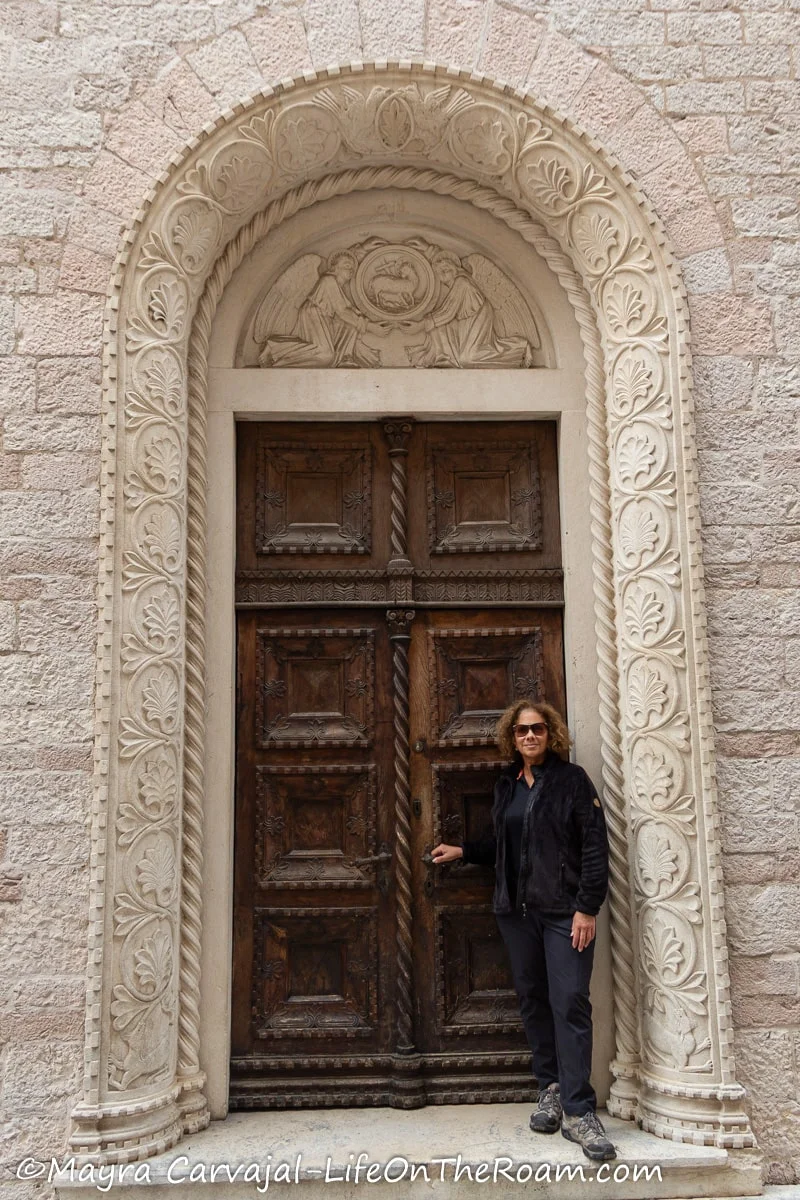

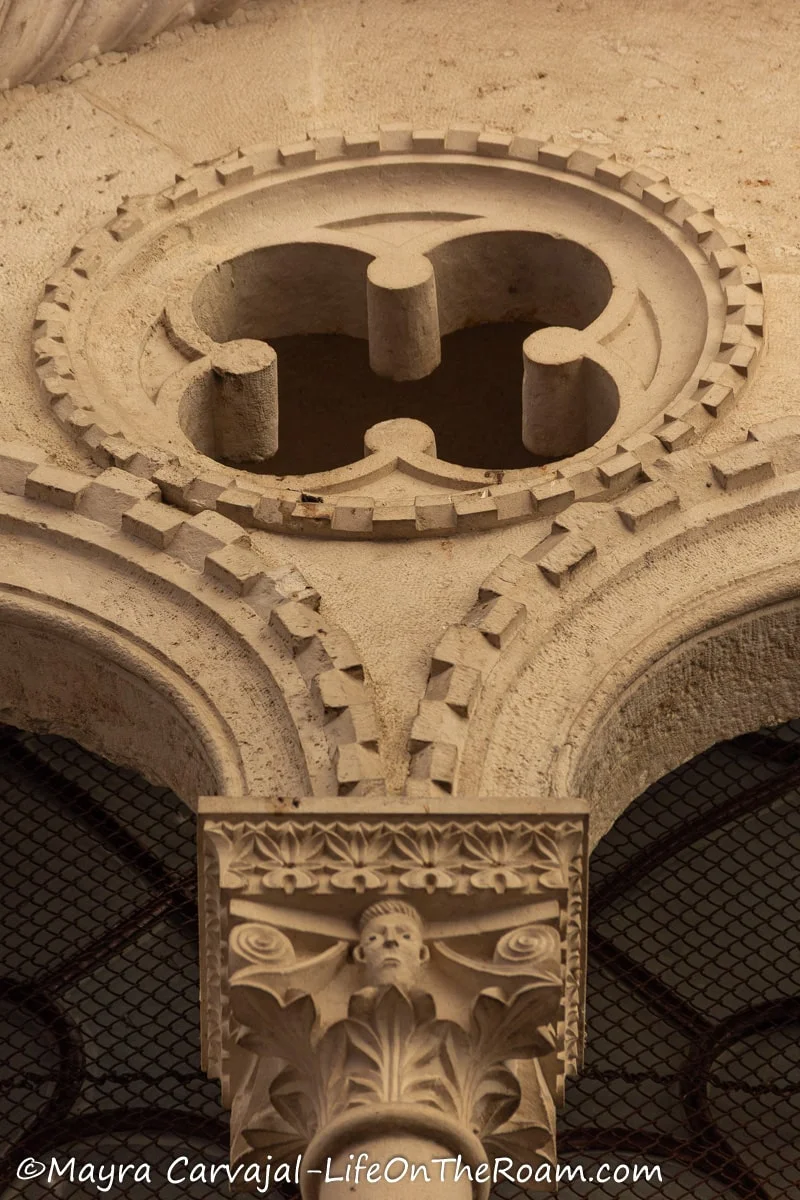
Back to the main entrance, you’ll see carvings of saints in the upper and lower sections of the big wooden doors that open into a treasure-trove totally worth the admission fee.
Some of the jewels you’ll find on the ground floor of the church are preserved fragments of frescoes from 1331, done by Greek painters and located in the apse of the south nave.
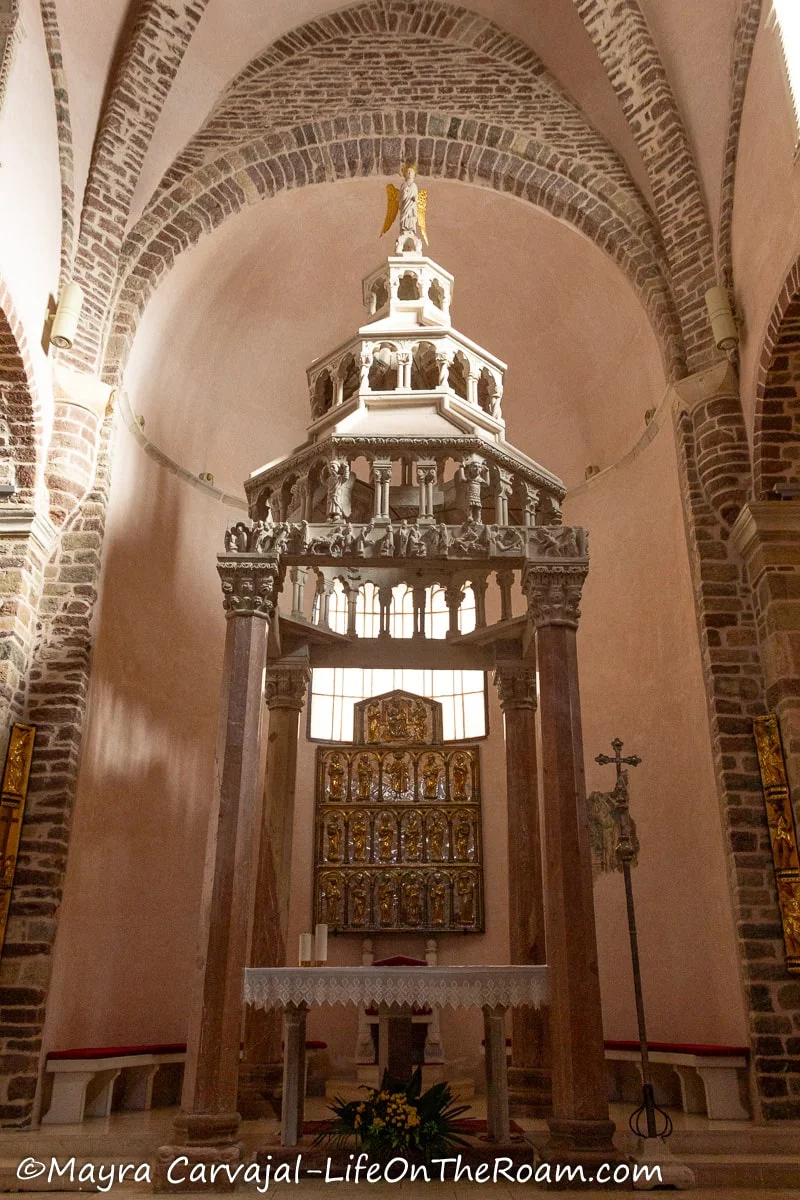
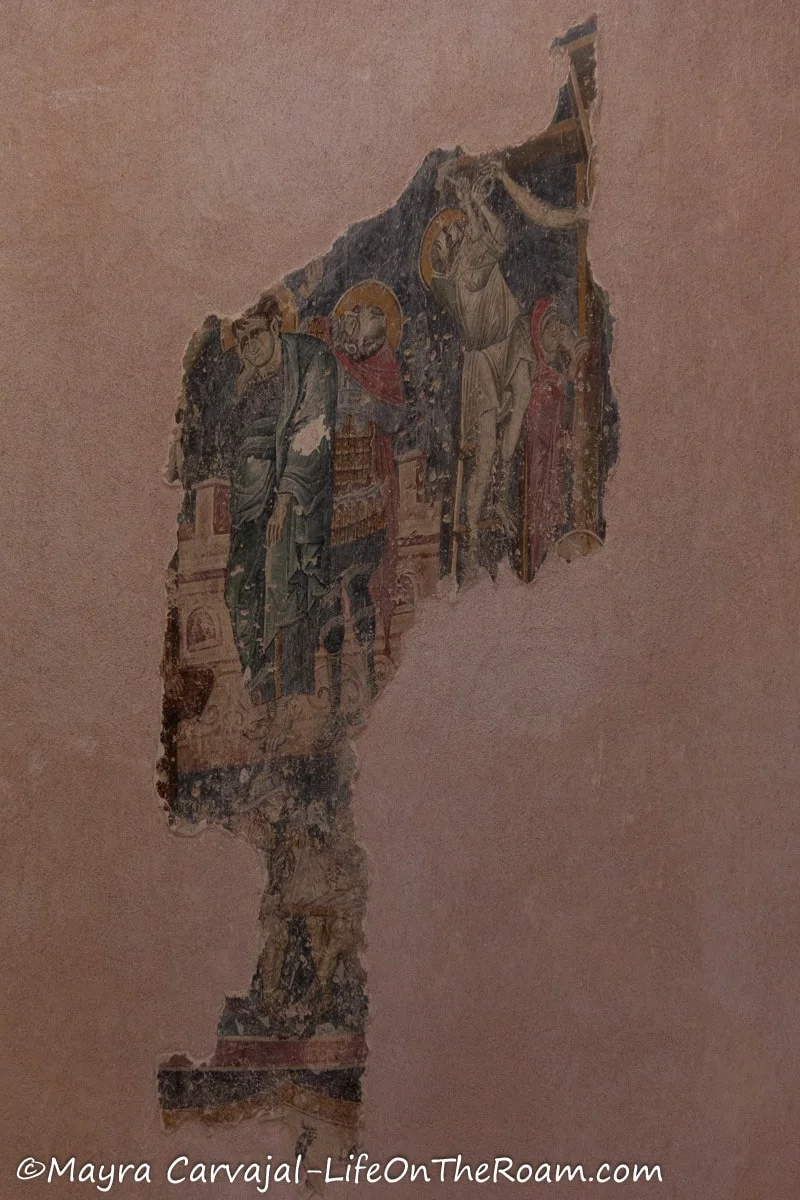
You’ll see other frescoes, in Byzantine style, covering a few soffits of the arches, columns, and coves above windows.
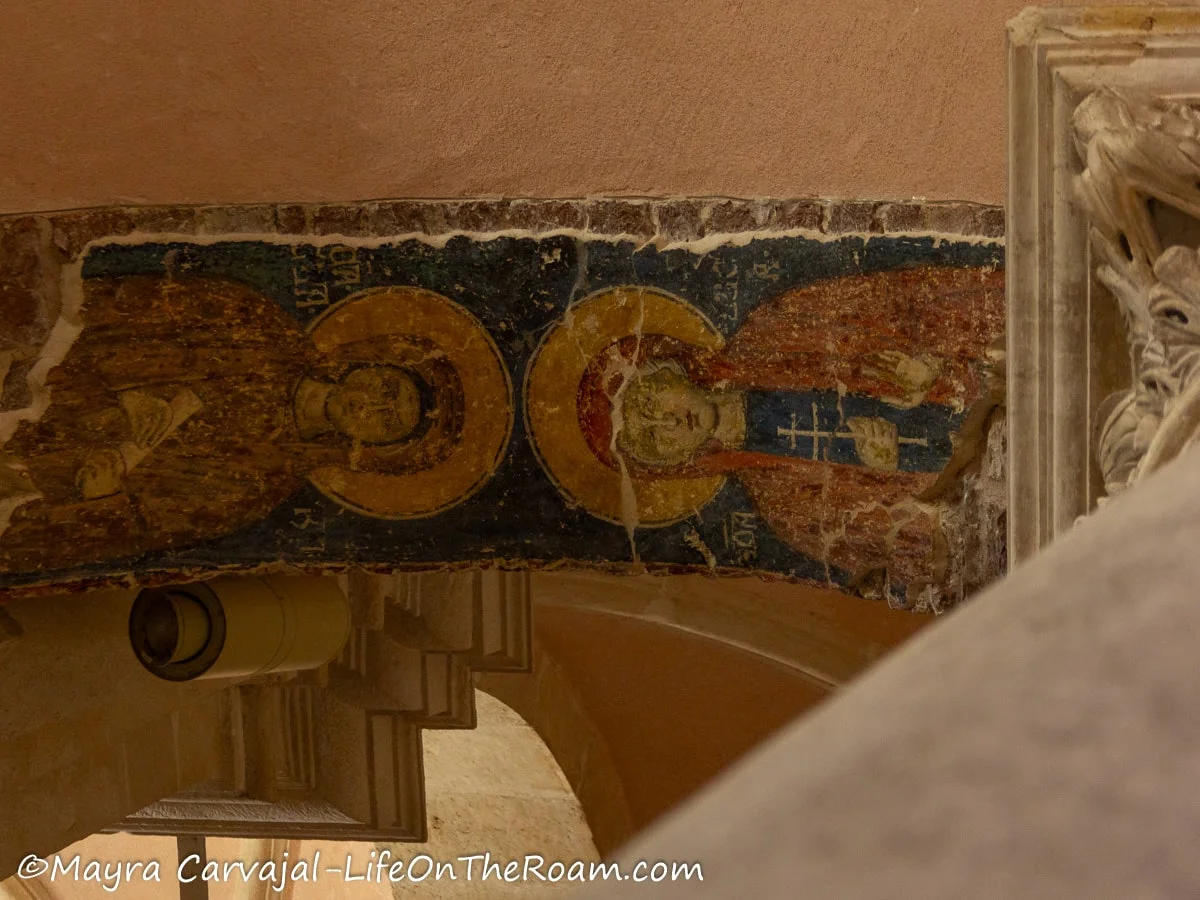

Go up to the first floor to visit the reliquary (Sacral Art Museum), where you’ll find Baroque-style sculptures and niches in marble like the one below (the main niche), with St.Tryphon and two angels:
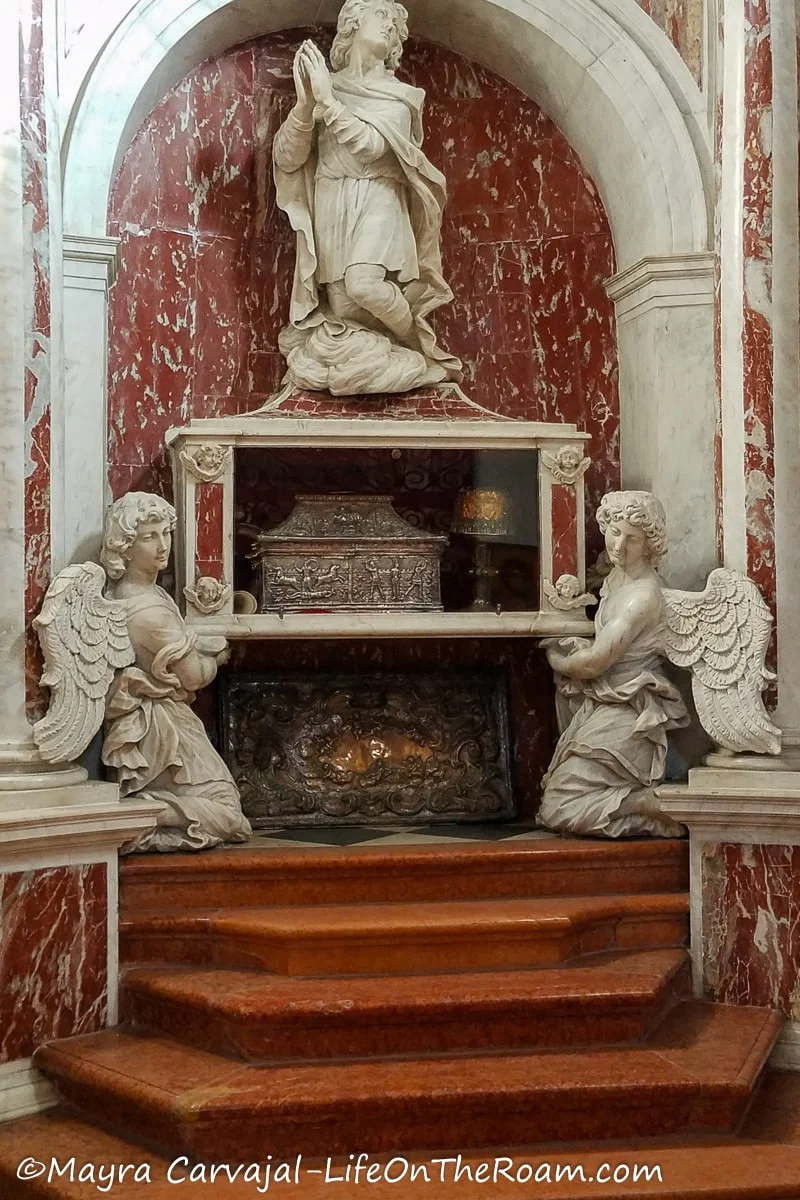
The angels hold a marble case housing a silver casket covered with reliefs depicting scenes of St. Tryphon’s life and martyrdom. Inside it holds his relics, consisting of his bones.
Venetian sculptor Francesco Cabianca was in charge of the interiors of the reliquary, a work he completed with his team over the course of four years.
Another impressive artwork in the reliquary is this Baroque-style wrought-iron gate made in Venice in 1652.

My favourite artwork is the amazing collection of highly detailed liturgical objects: beautiful examples of goldsmithing and silversmithing, some of them with precious stones.
The relics are interesting, but also kind of creepy, with a window to show the bone fragment of some church saint.
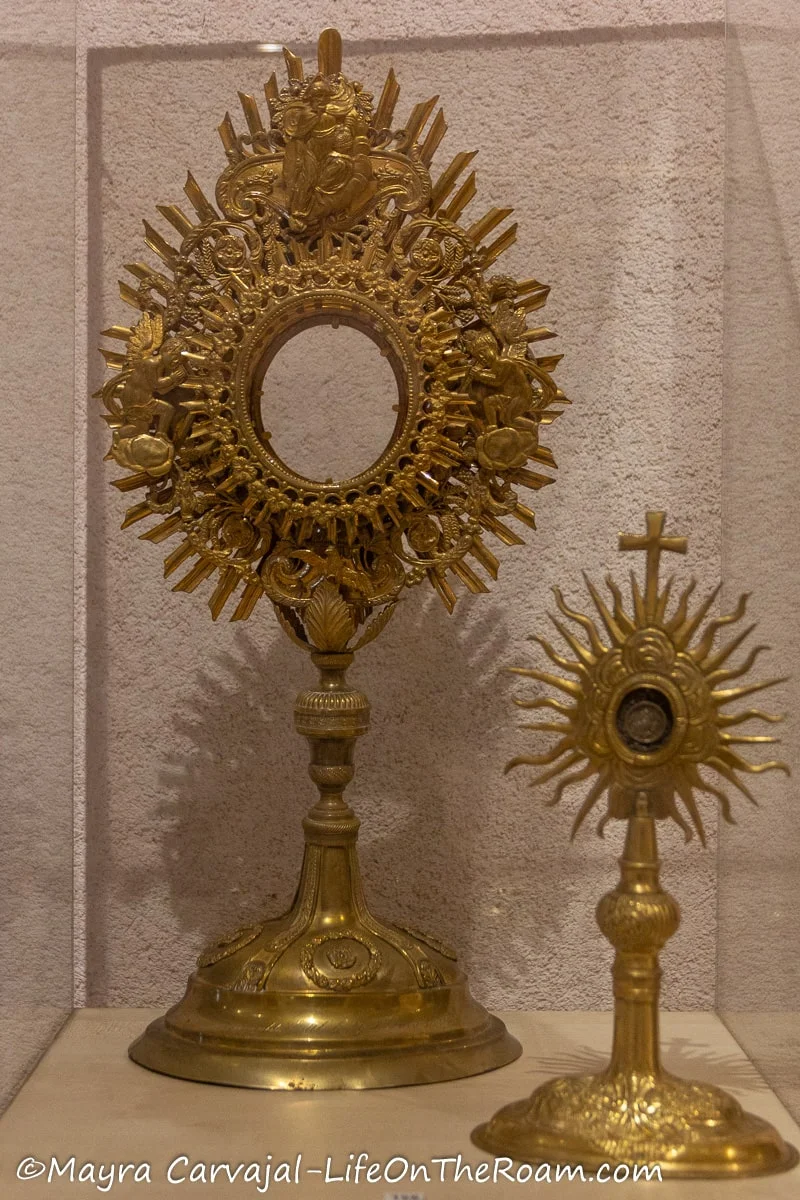
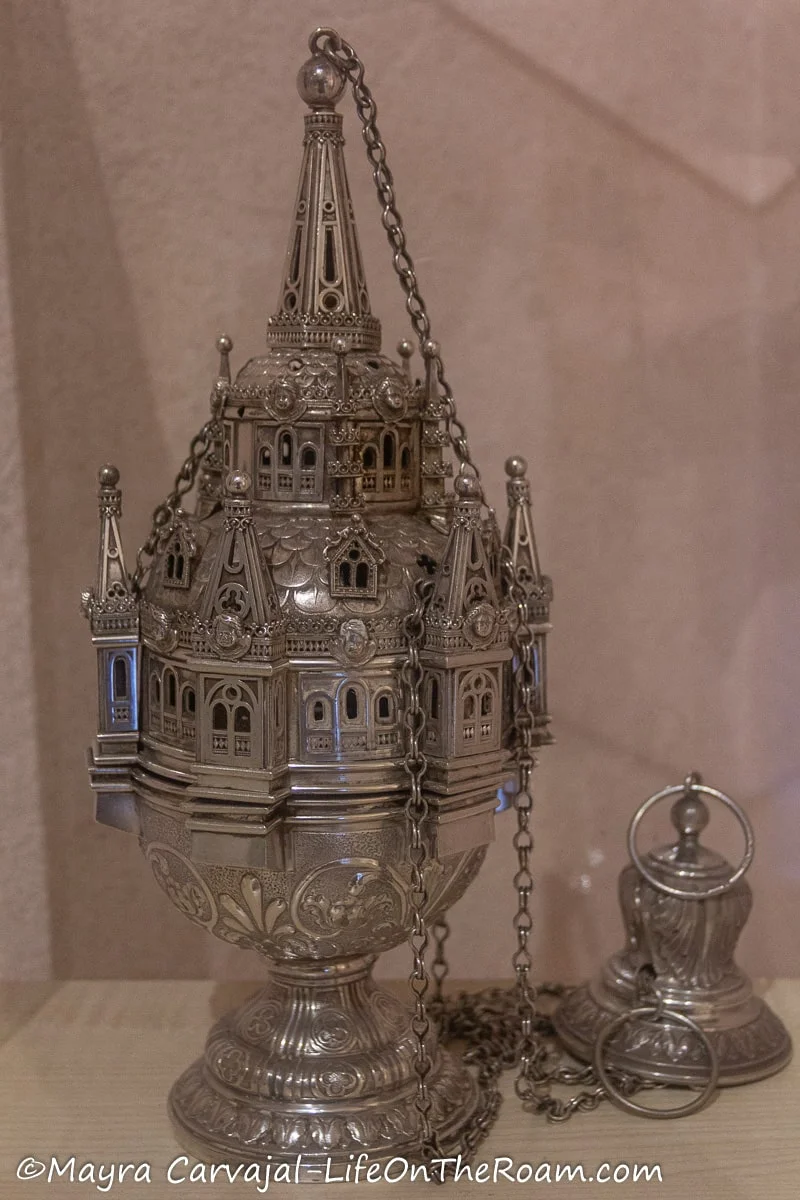
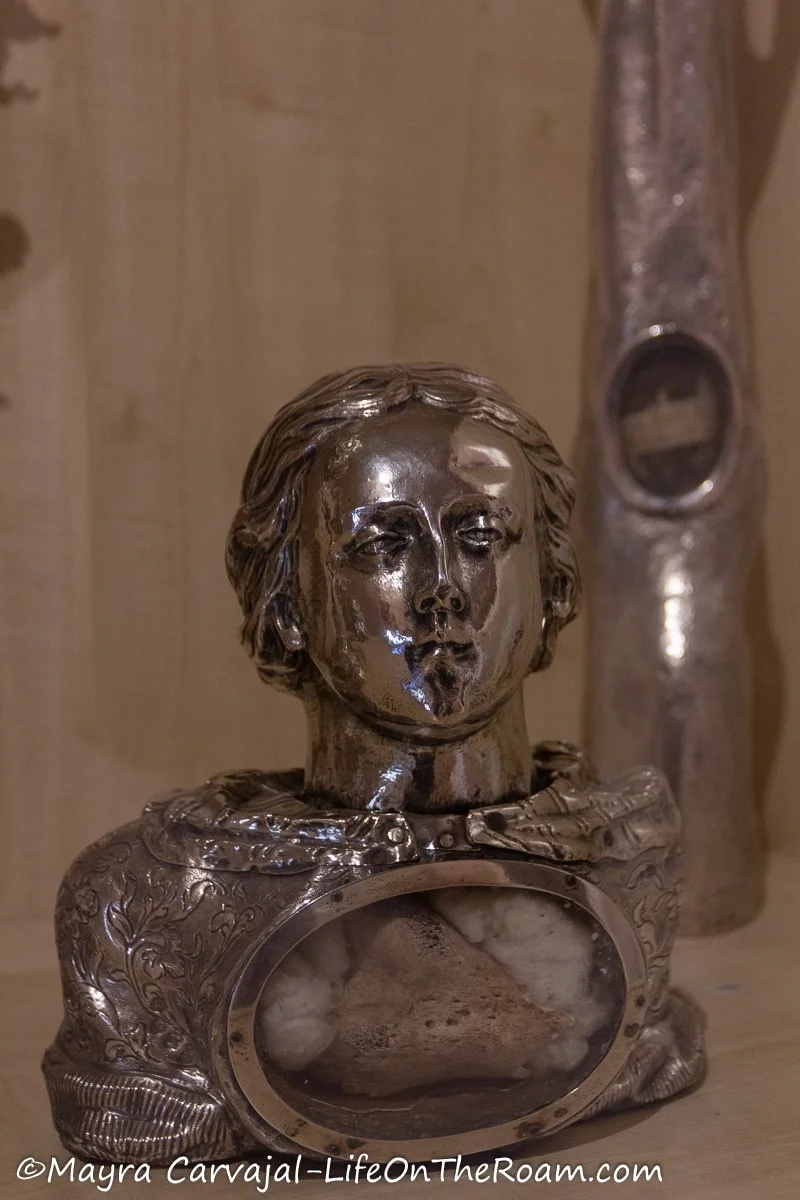
You can also see historical books, wood sculptures, and antique pieces of fabric with embroidery.
Don’t miss the view of the square and the Drago Palace from the terrace.
General admission: €4
St. Nicholas’ Church
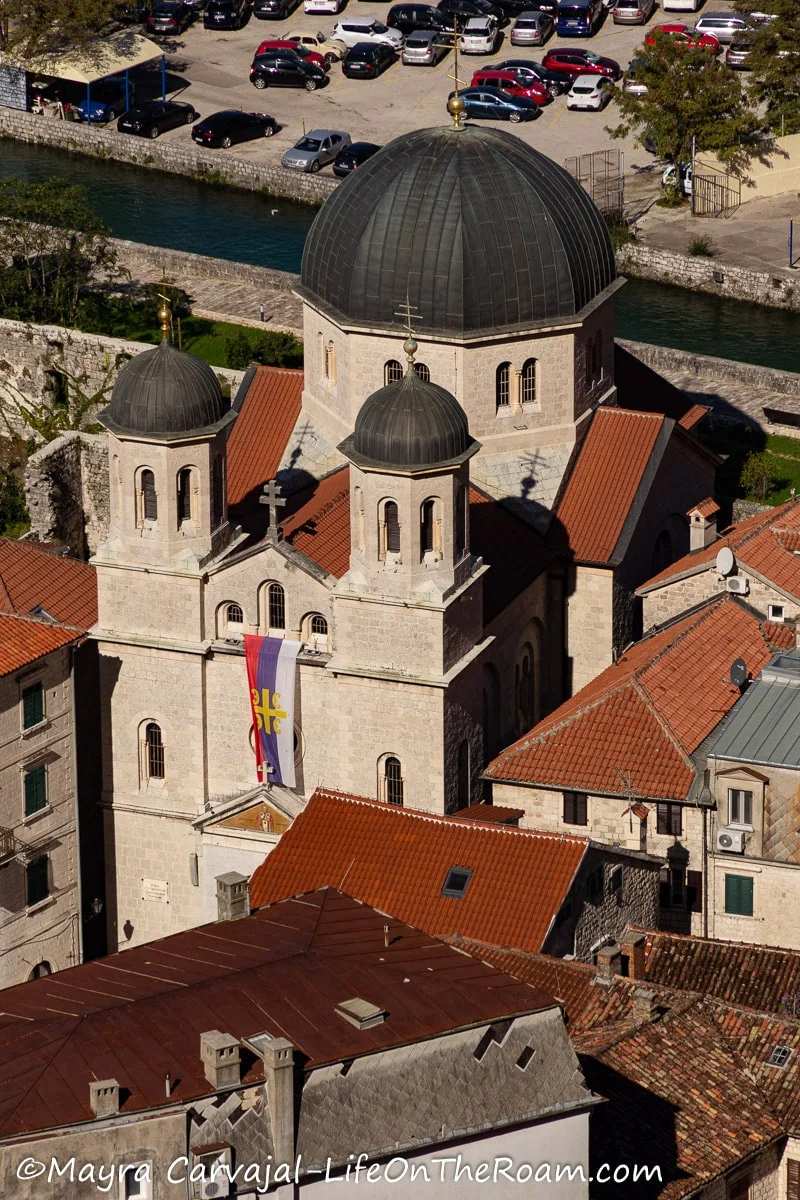
The distinctive feature of this Orthodox Church, built between 1902 and 1909, is the impressive work of silversmithing across the iconostasis in the form of a riza: a thin metal sheet with detailed bas-relief covering the painting of a religious figure, except for (generally) the face and hands.

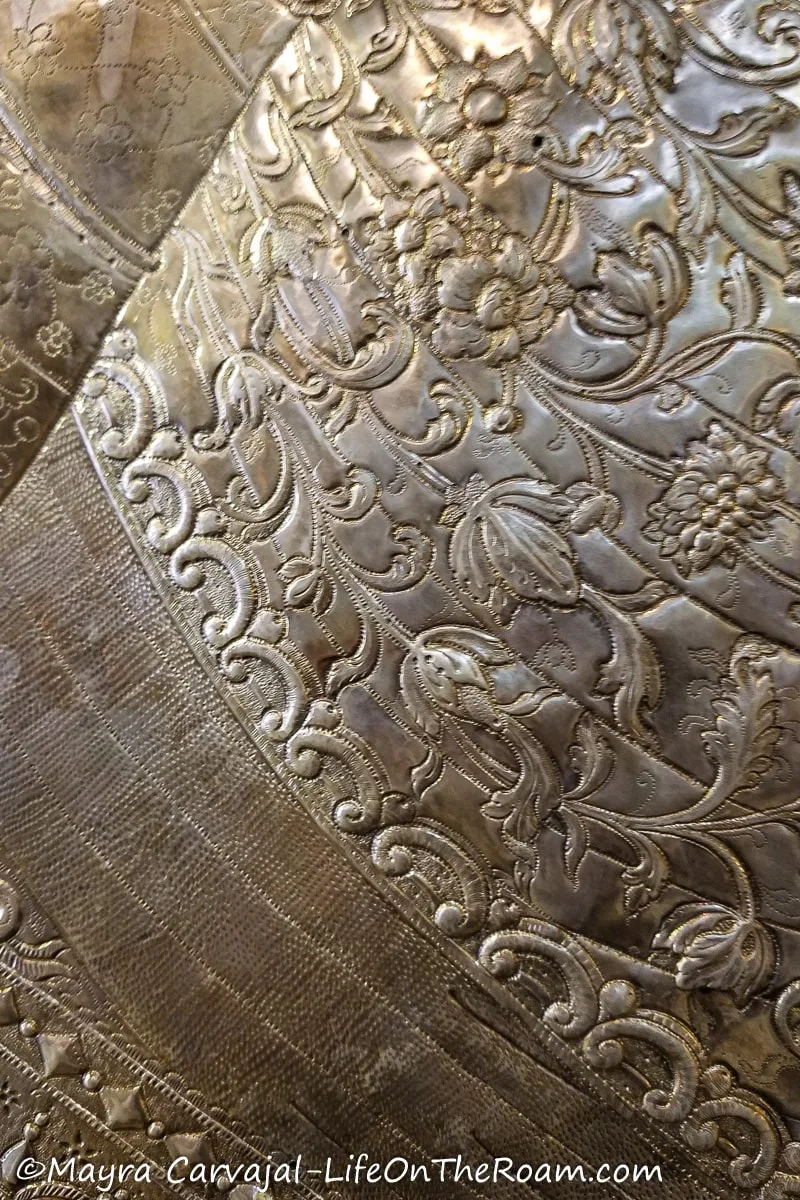
At St. Nicholas’ Church, located across St Luke’s church, you can also see massive paintings of the four evangelists: a donation of the Russian church in 1998.

St. Luke’s Church
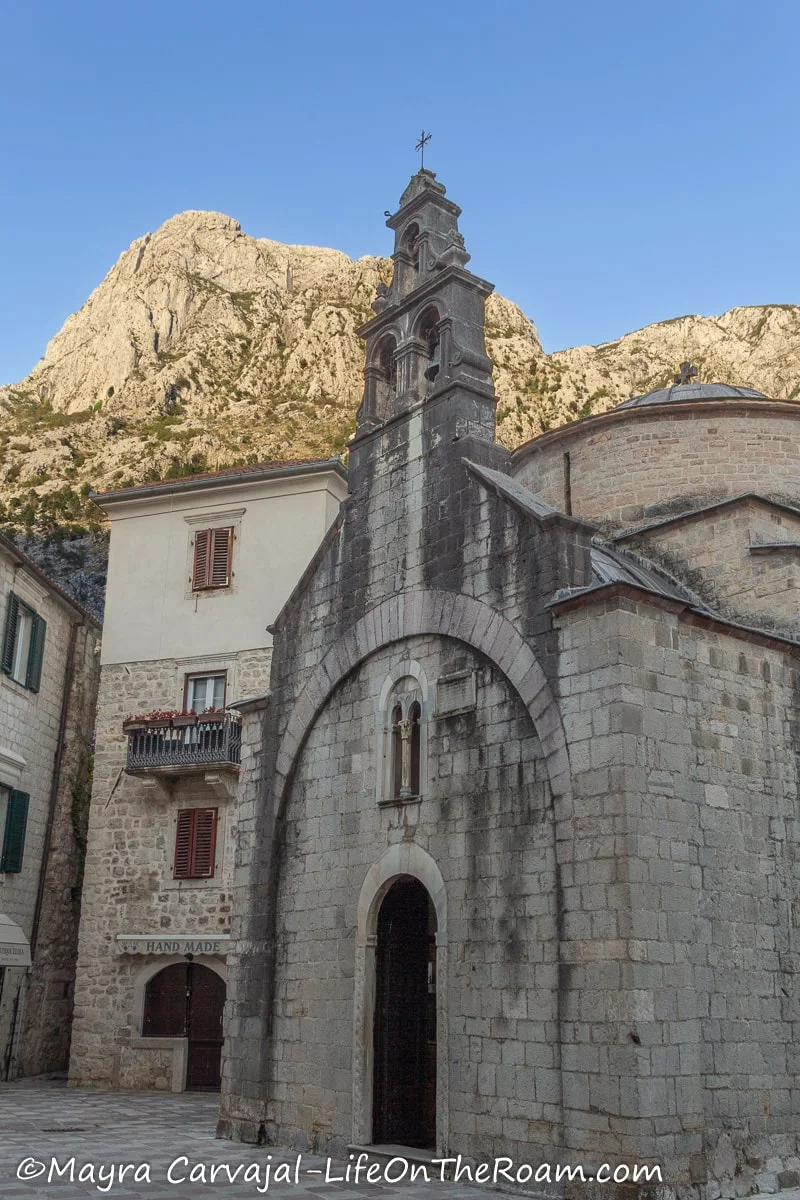
This Early Christian church, built in 1195, first served the Catholic community and then both the Catholic and Orthodox communities until it was dedicated to the Serbian Orthodox Church.
St. Luke is small when compared to other churches in Kotor (actually to any other church), but it was one of my favourites thanks to its unique 17th-century iconostasis. They’re older and somewhat different than most of the ones I’ve seen around Montenegro.
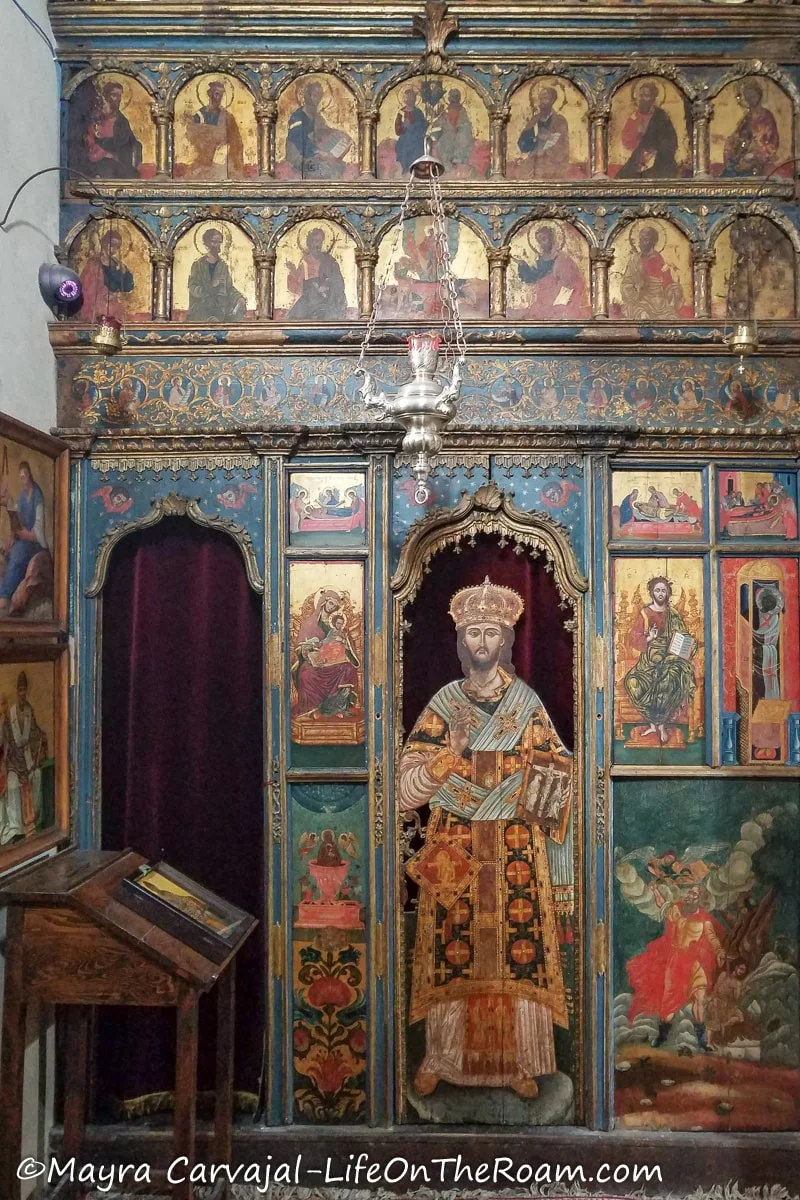
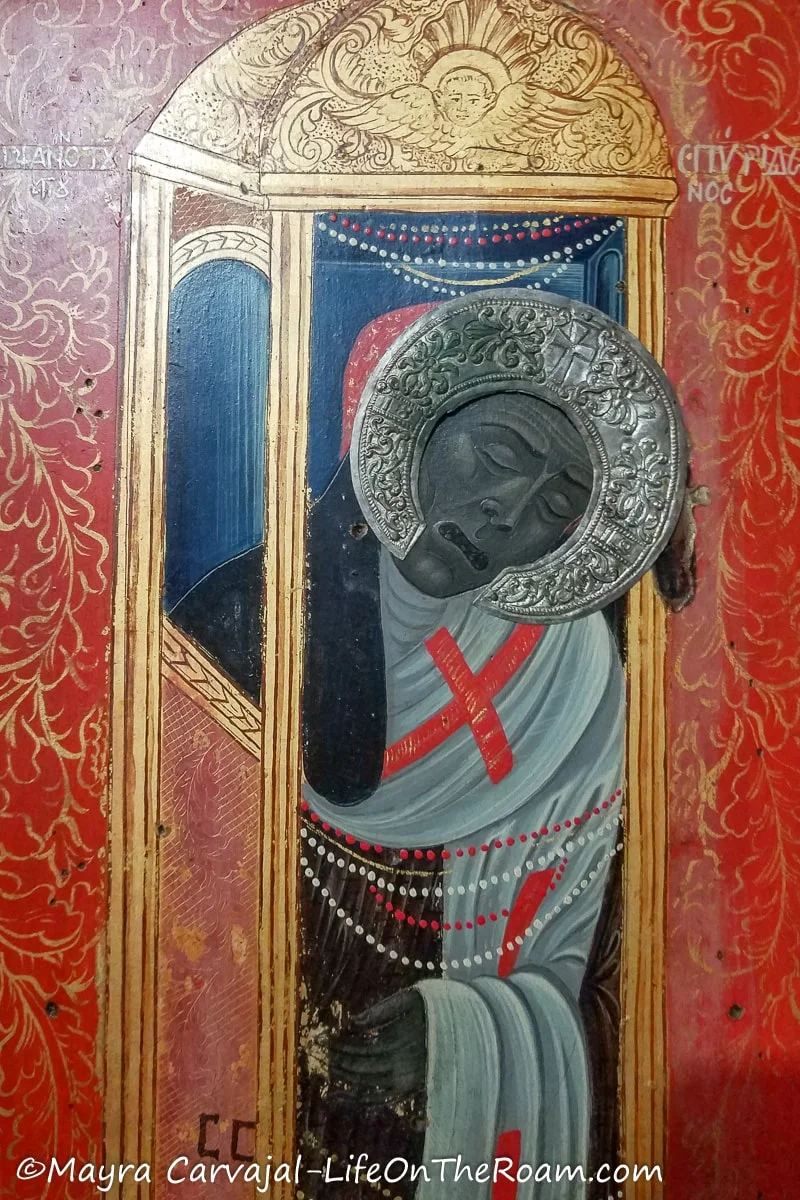
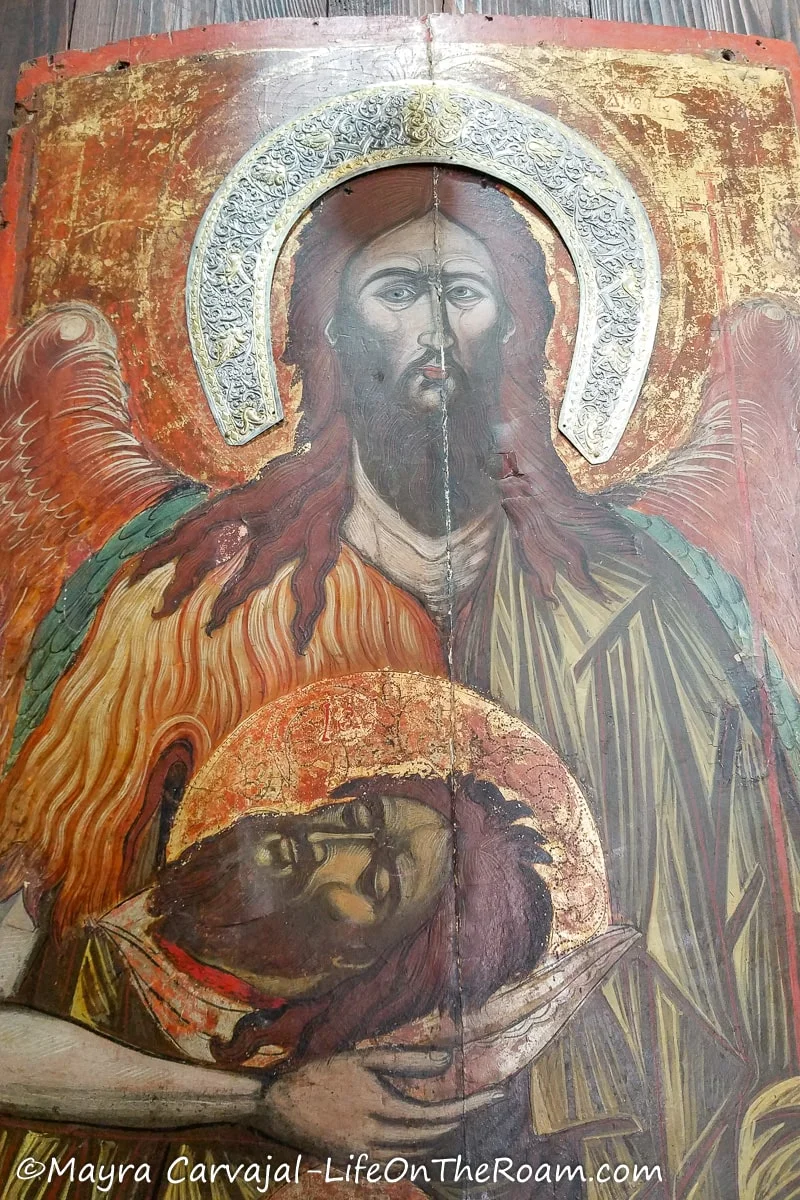
You can also delight in fragments of the original 12th-century frescoes.
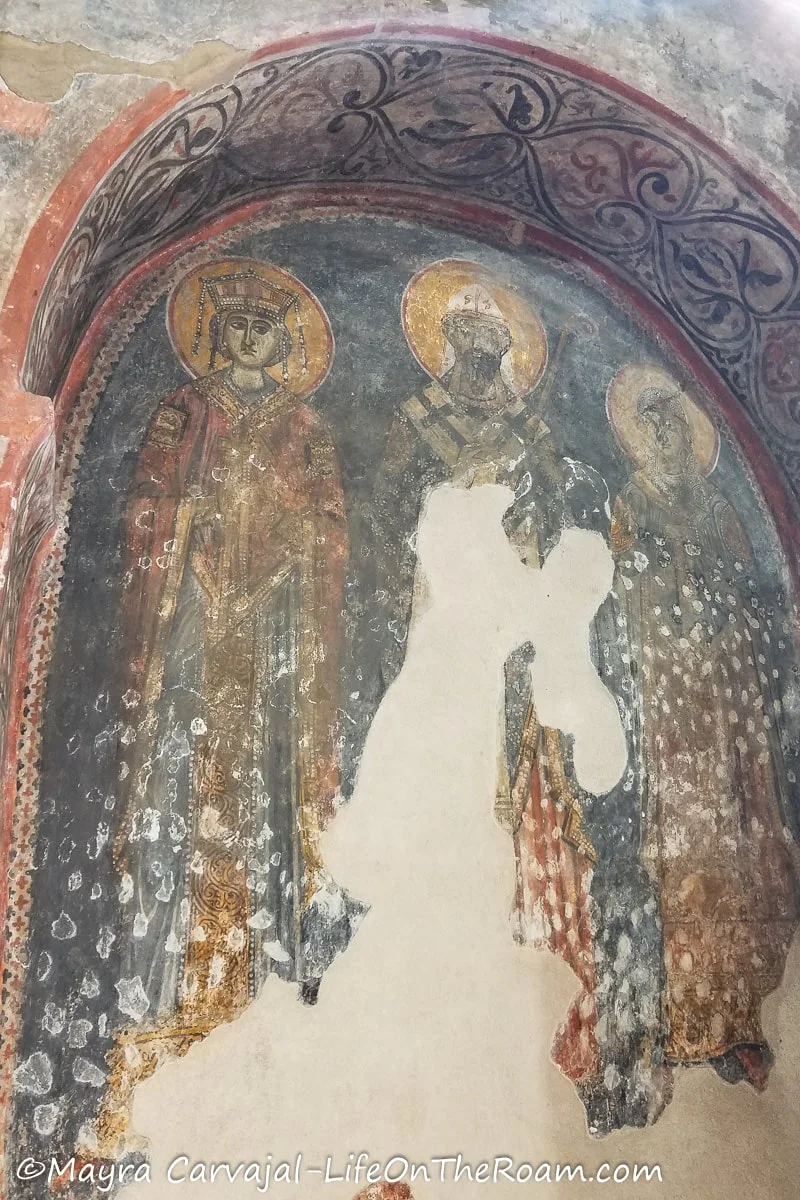
Don’t have time to get lost in Old Town Kotor alleyways?
Old Town Kotor Walking Tour: learn about the history and culture of Montenegro while you stop at squares and churches around Old Town with this highly rated 70-minute guided tour.
Book this tour here, with a rating of 4.9/5 based on more than 70 reviews
Do you prefer a private tour? This 1.5-hour guided walking tour has a rating of 4.8/5 based on more than 90 reviews
St. Mary’s Collegiate Church at the Square of Wood (Trg od Drva)
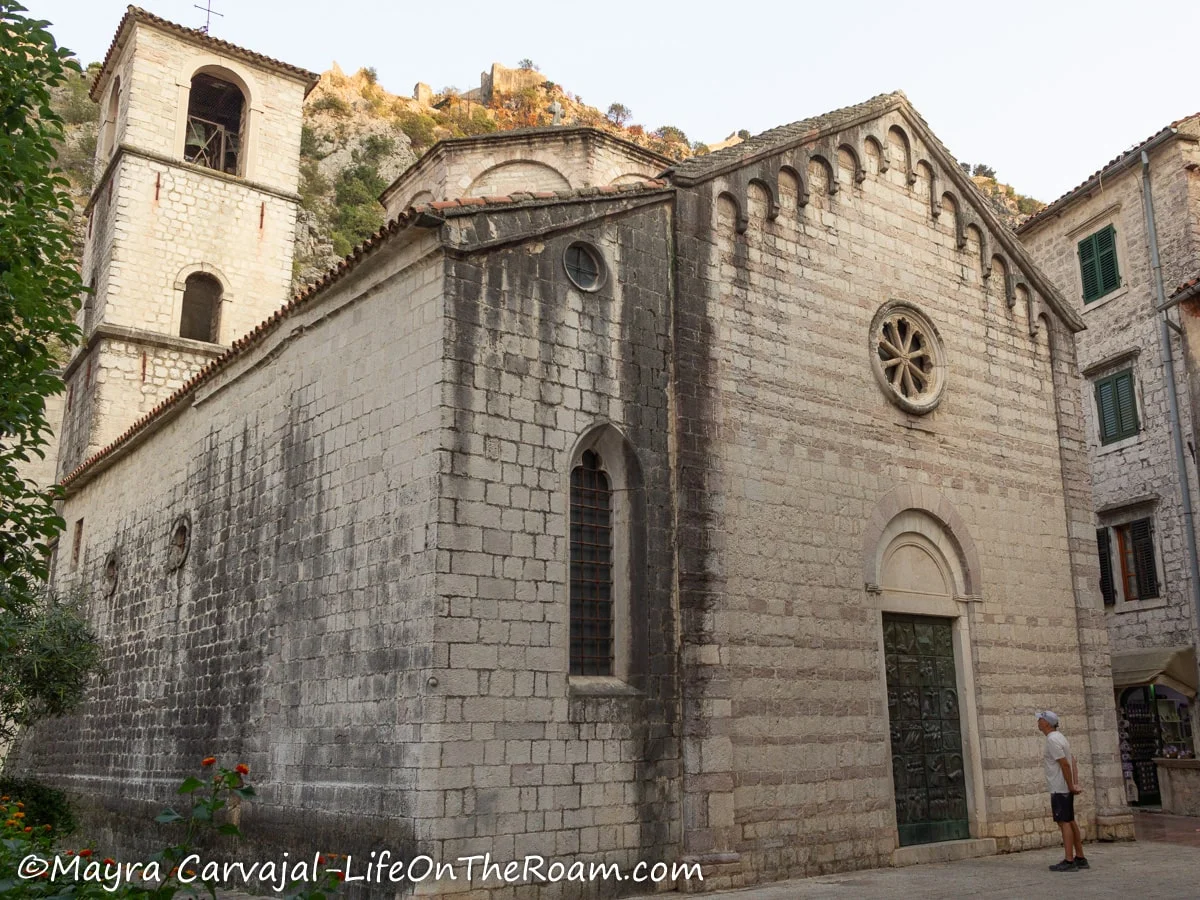
You’ll know you arrived at this church as soon as you see its huge bronze doors featuring 24 bas-relief panels with scenes of the life of Blessed Osanna (a saint of the Catholic Church) and her role in Kotor’s history.
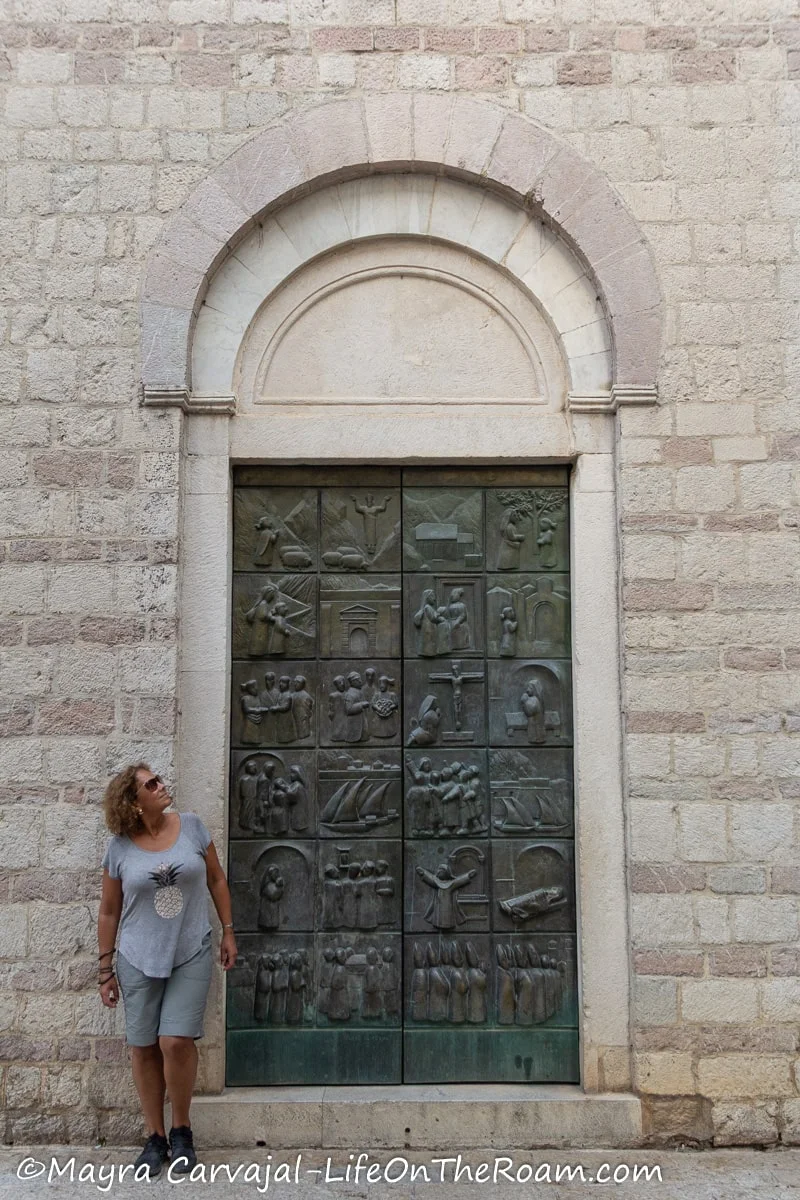
I mention her in the next section, when I tell you about St. Paul’s Church and the attached monastery where she spent most of her life in isolation.
Even though the doors are from the 20th century, the church was built in 1221, on top of a 6th century basilica.
In the 15th century they added the St. John’s Chapel. If you see the roof from the nearby ramparts you can clearly notice the add-on. You’ll also have a nice view of Trg od Drva, a lovely square with benches and big trees, a marble fountain with cool floral and geometric patterns, and many, many friendly stray cats around.
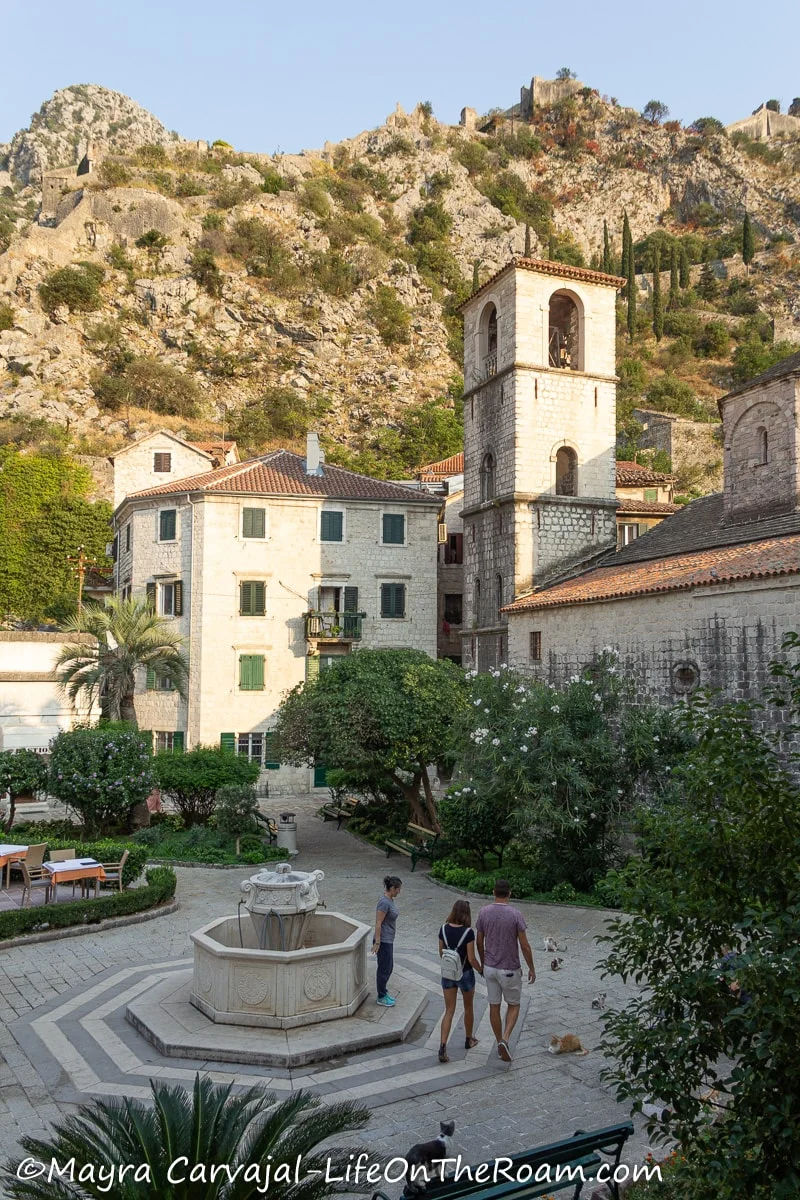
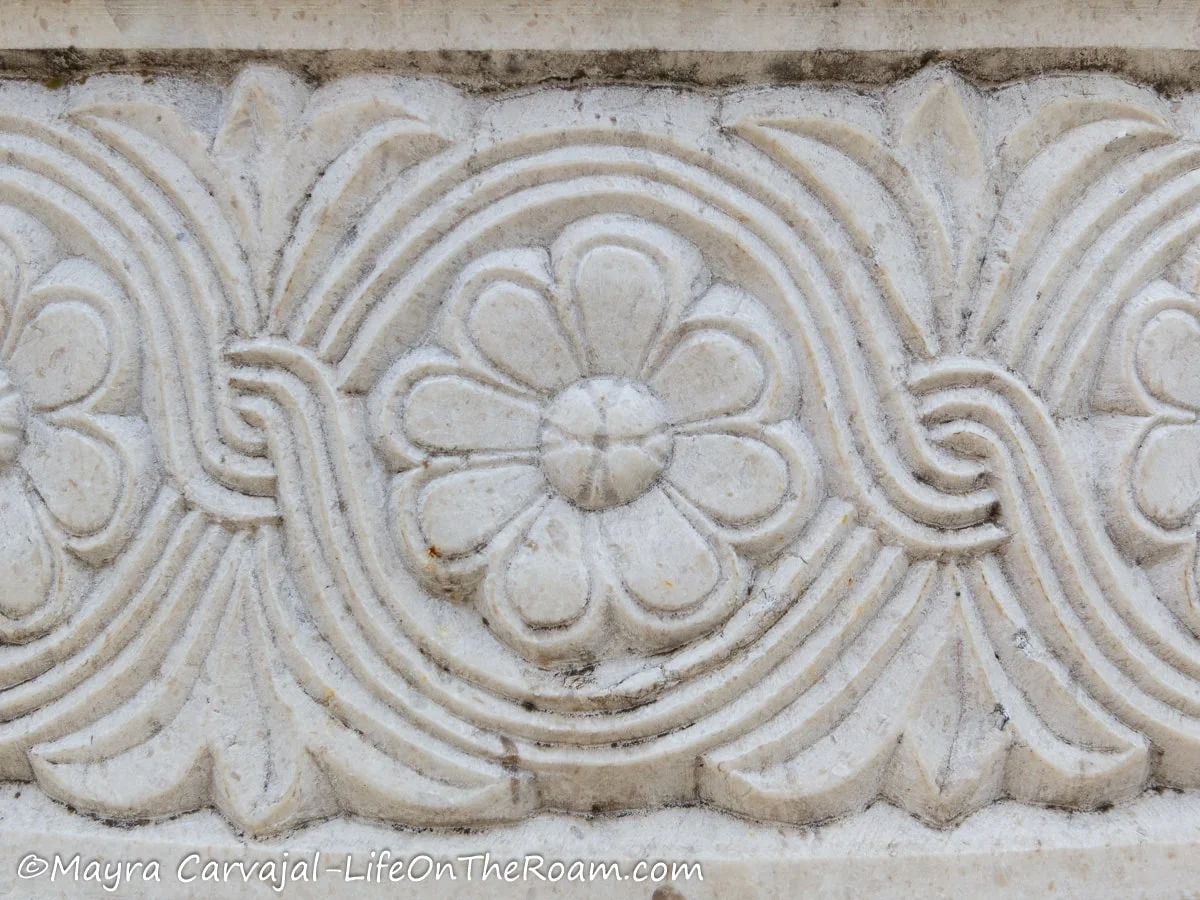

There are people who take care of the cats and built houses for them on a section of the square (like a cat park). But there are too many stray cats. If you want to help the kitties you can visit Danijela’s Cats Shop, located nearby, where you can buy handmade souvenirs to support Danijela’s efforts and you can also donate or bring sealed bags of kibble and treats.
Back to the church, I can’t tell you much about the fragments of the 14th century frescos, or the Baroque-style multi-colour marble altars, or the relics of Blessed Osanna because during the entire month I spent around Kotor this church was always closed. I wish you better luck.
General admission: €4
St. Paul’s Church

No longer a church, but a museum. It was built originally as a church in the 13th century in Romanesque style, and reconstructed in the 16th century. Then in the early 19th century, when Napoleon invaded Kotor, it was used as a military barrack, then as a prison, and it was never used as a church again.
I recommend you to visit this tiny museum only if you’re really into history or if you have time to use the €5 combined ticket that gives you access to the Lapidarium at the Church of St. Michael and the Gallery of Solidarity.
The most significant features here are the small fragments of a 13th-century fresco found on the arch of the arcosolium (a medieval arched tomb located near the entrance) with the image of St. Paul.
Inside the ex-church, through a glass floor, you can see the original stone floor underground and a bit of the original walls.
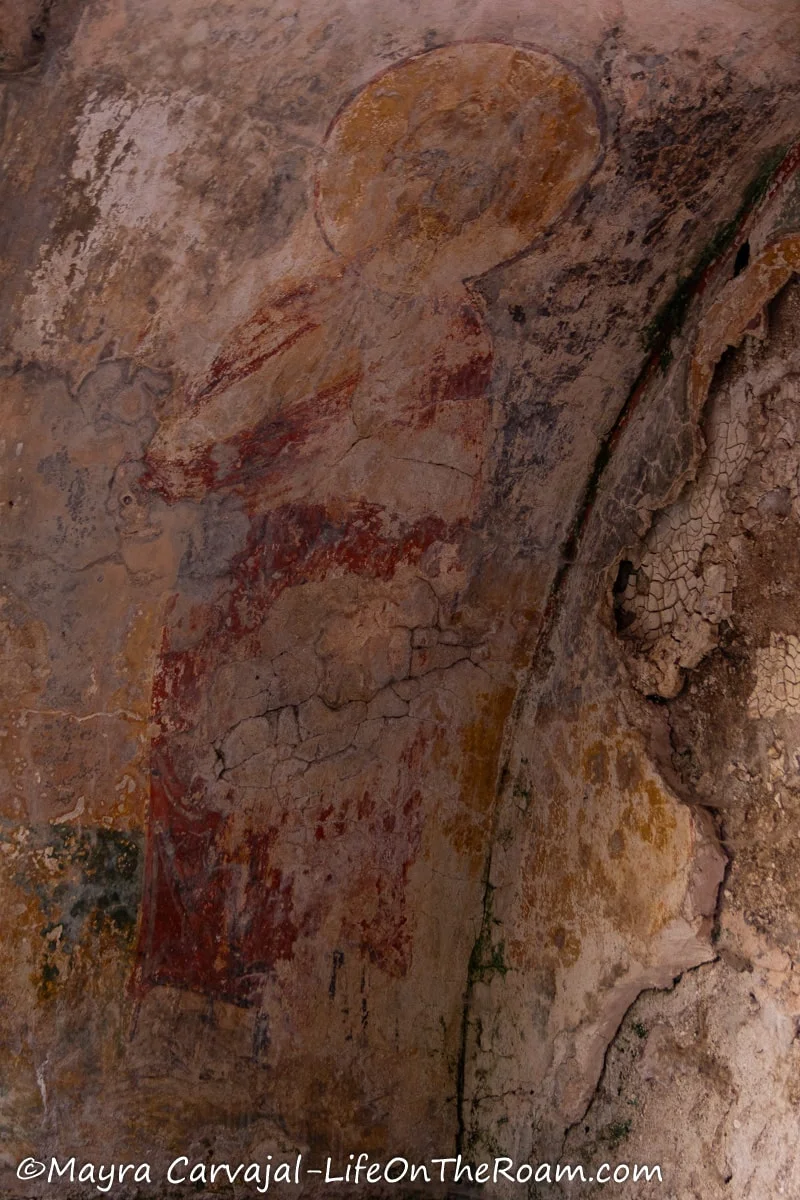

Other than that, except for some details here and there, most of the walls are refinished and painted white (it looks nothing like a church). The space is now used for temporary exhibits, which can be a hit or miss. There’s a miniscule room (you see it through a small window) which was part of the Dominican Monastery built next door. During the 16th century, a nun known as Blessed Osanna spent most of her life here in isolation until her death, devoted to prayer.
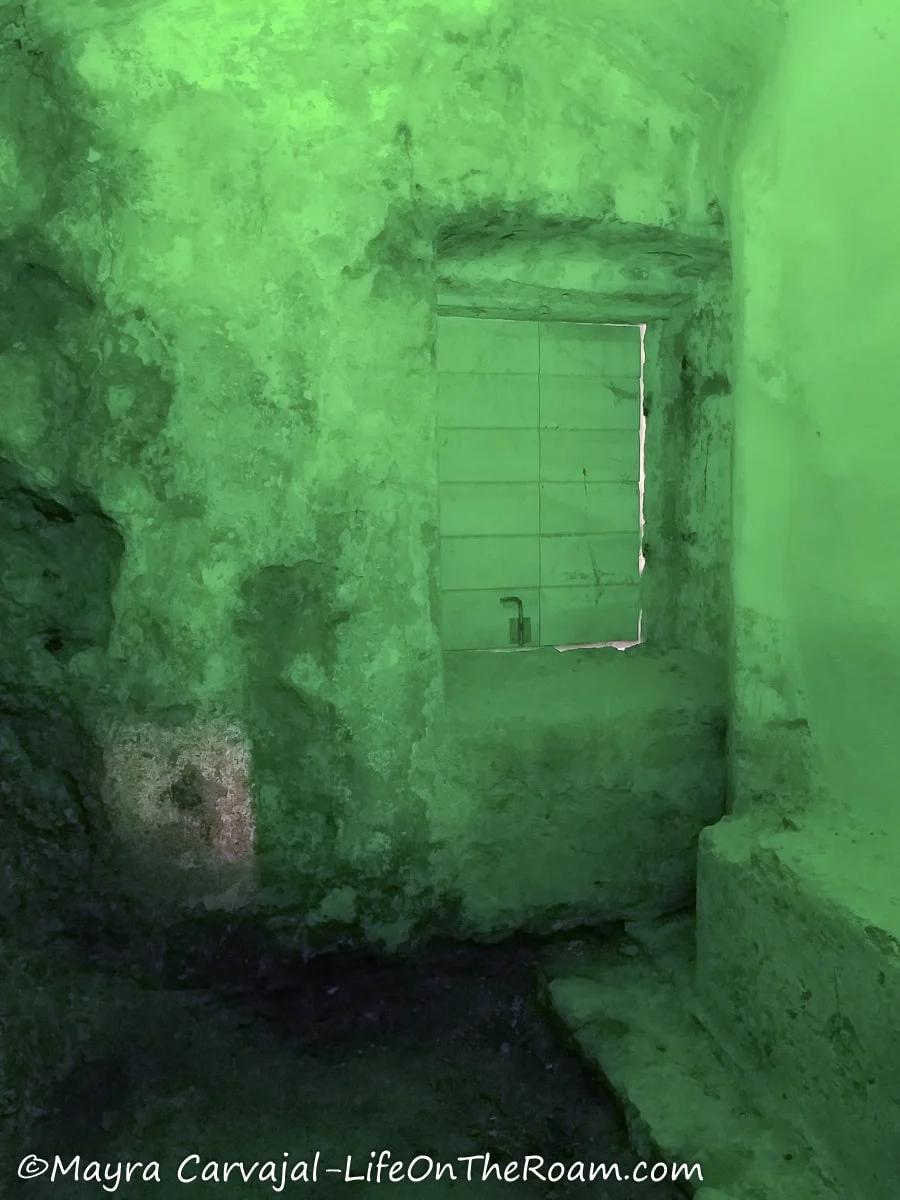
She only left her cell once during the fifty years she lived here. At the request of the Bishop, she came out to embolden the people of Kotor to fight a Turkish invasion. The whole town was inspired, fought the enemy until they retreated, and she became a hero.
It’s been said that she performed miracles and the Catholic Church declared her a saint in 1930. Centuries after her death she got a new coffin (which rests at the St. Mary’s Collegiate Church), and to everybody’s surprise her body was intact.
In the outside area of the upper level you’ll find a display of artifacts from the Lapidarium, mainly architectural ornaments from the Roman era to the Baroque period. Most have nice carvings with floral motifs and geometrical patterns, and some even have inscriptions in Latin.
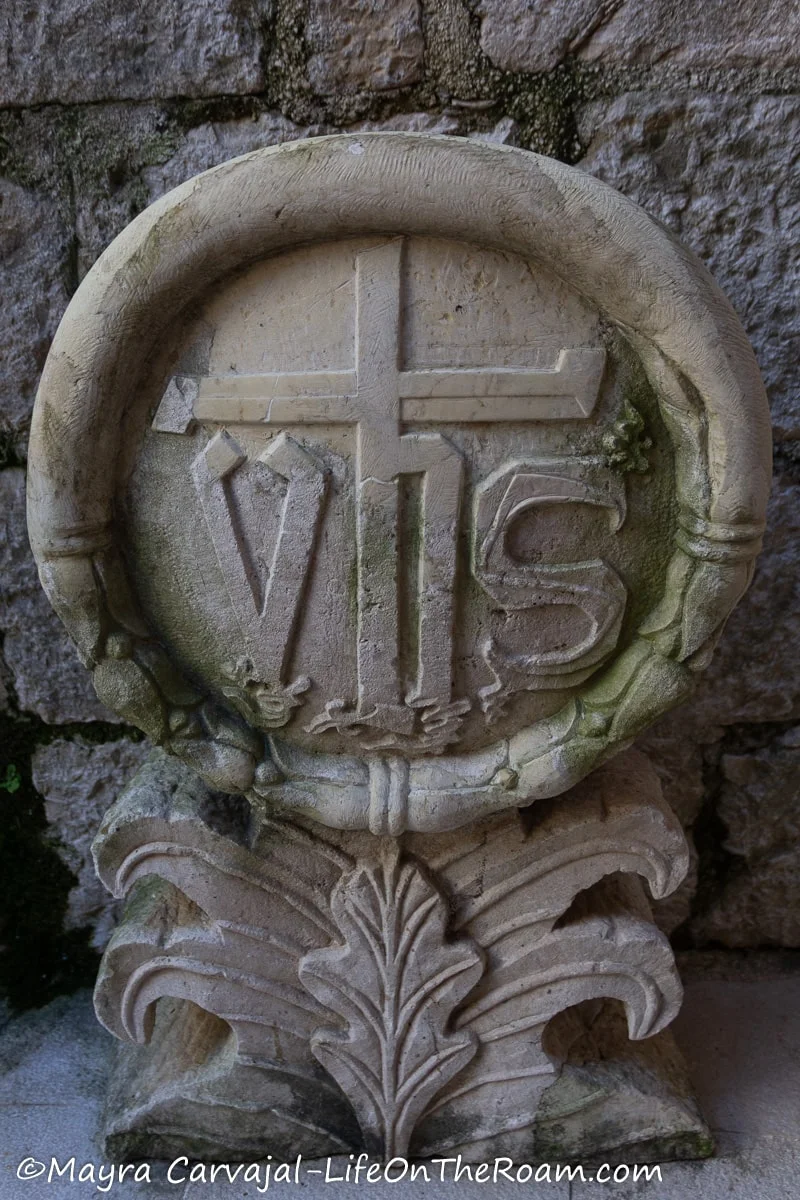
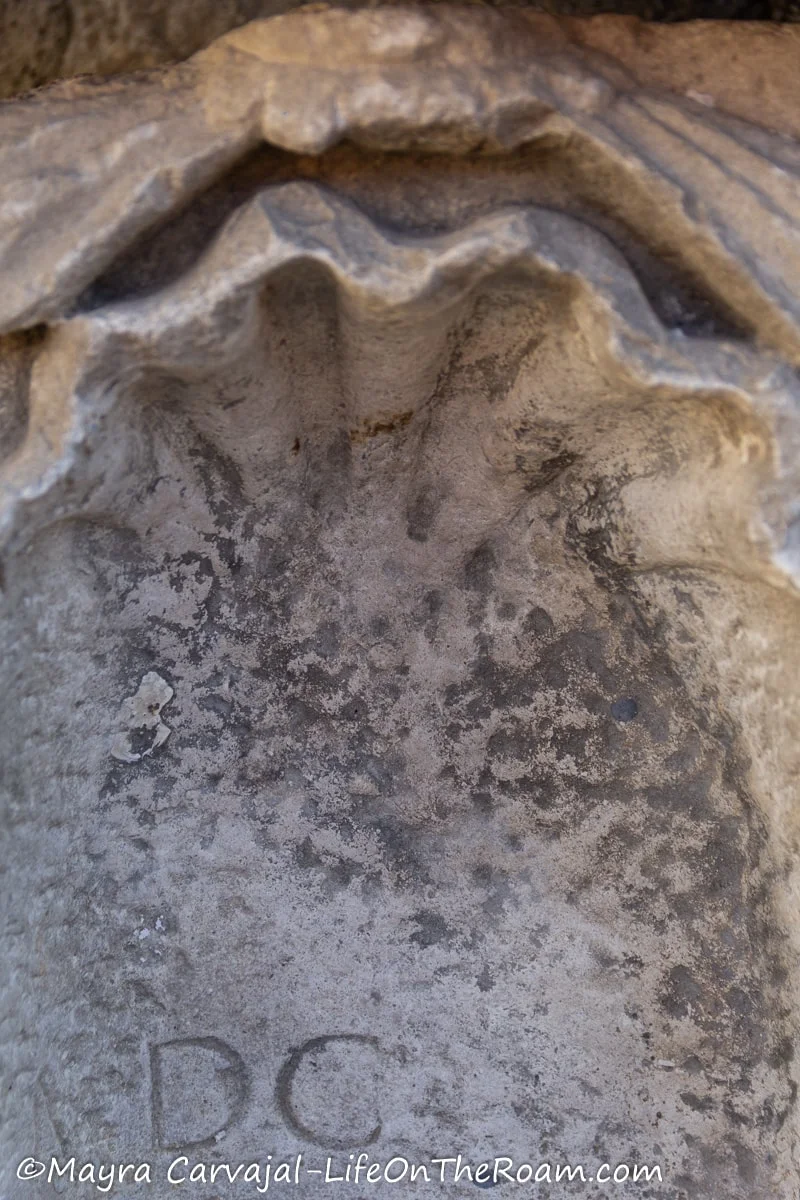

The Church of St. Paul is located on the street behind St. Tryphon’s Cathedral.
Lapidarium Museum at St. Michael’s Church

This small museum lives inside a former church built on top of two previous constructions: an early Christian church from the 6th century and an early Romanesque church from the 9th century.
The building you see today, in Romanesque-Gothic style, was built between the 13th and 14th century reusing some stones from the old construction. It was restored at the end of the 20th century.
Inside you can see traces of the original beautiful frescoes from the 15th century.

The underground level around the apse is exposed to show recovered elements from previous periods, some dating back to the 6th century. There are fragments of frescoes from the pre-Romanesque period.
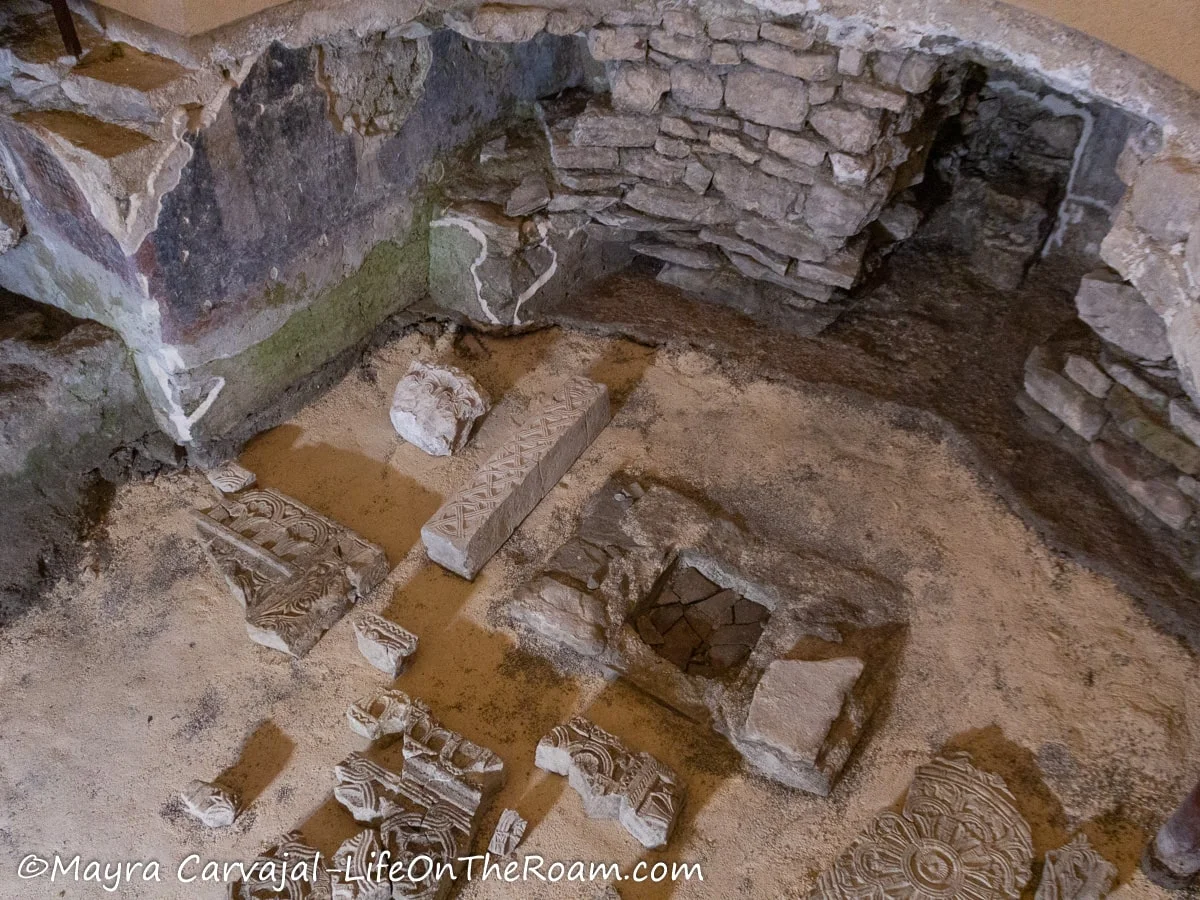
You’ll also see pieces from the Roman era like the bust of Emperor Domician (1st century A.D.), and from the Early Christian era like the representation of the Lamb. There are several other pieces including architectural ornaments from pre-Romanesque times up to the Baroque.
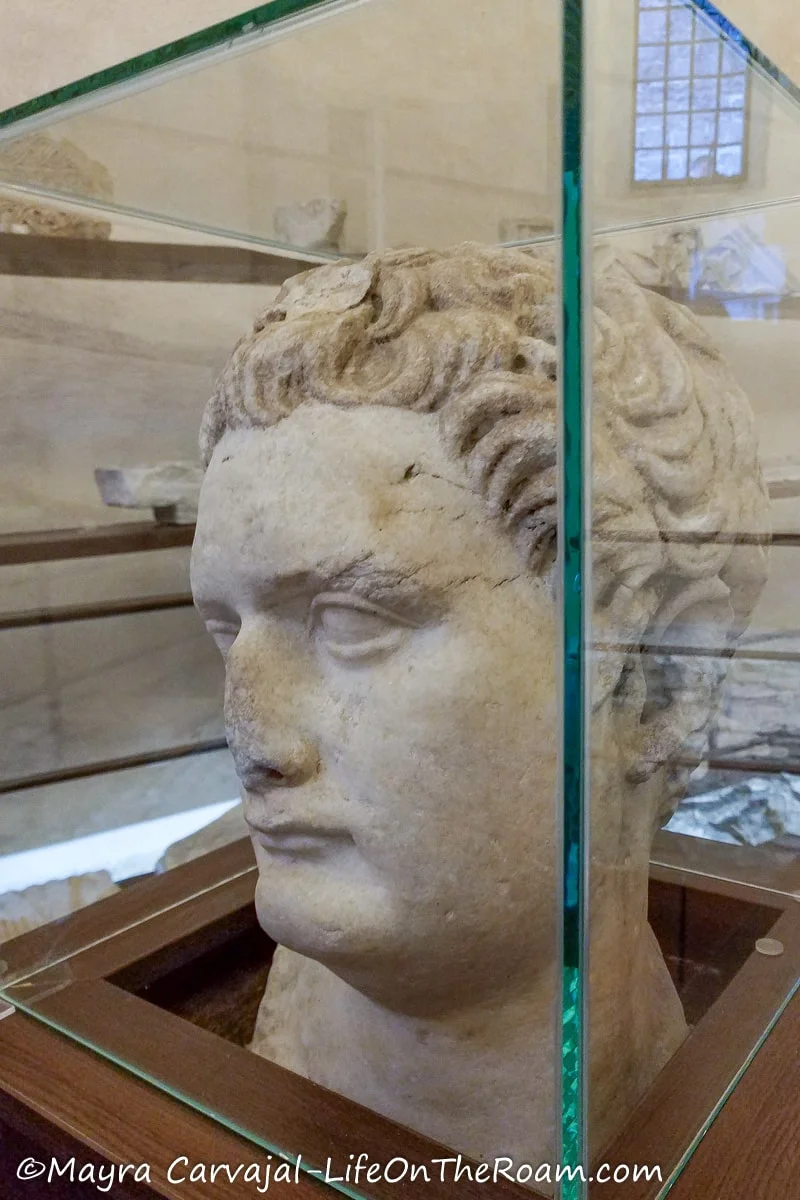
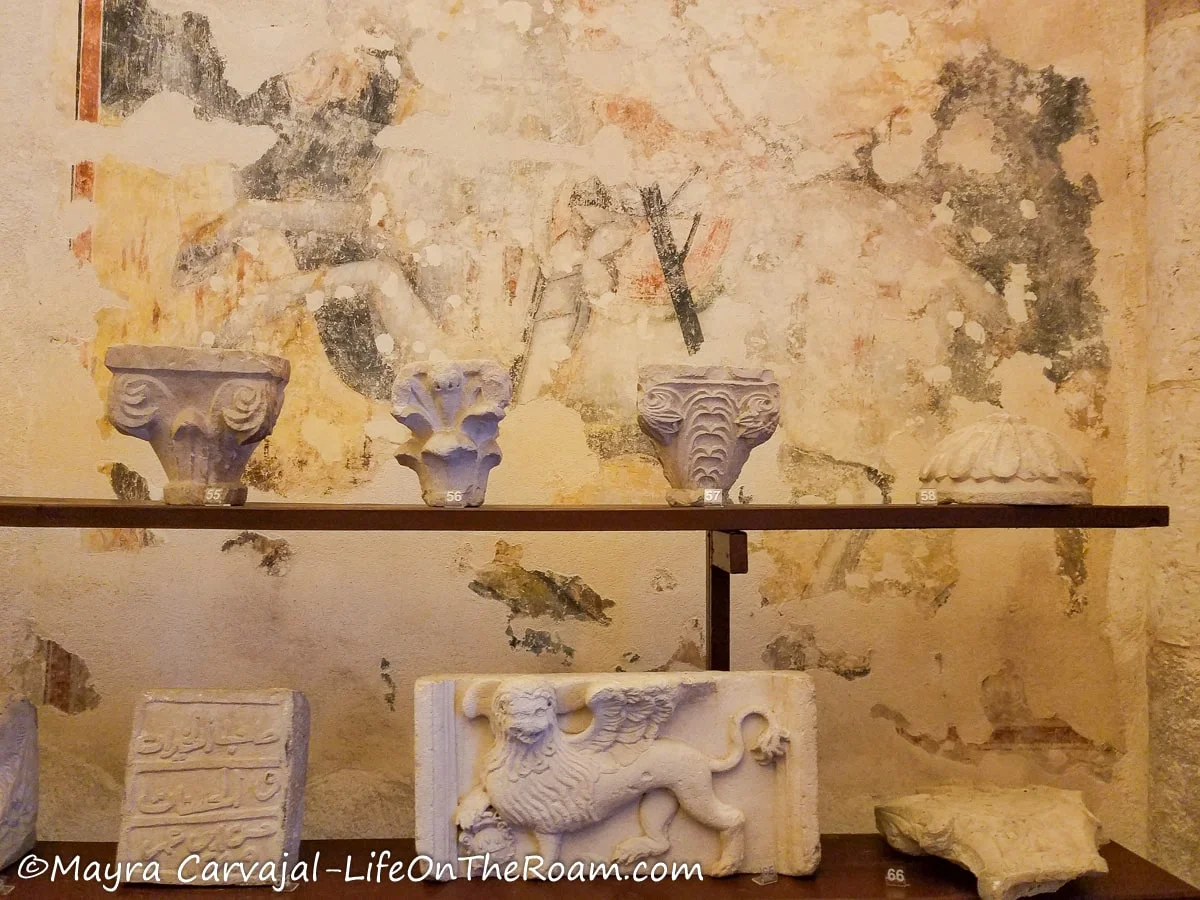

Outside you’ll find more ornaments, including coats of arms with beautiful details.



It may be small, but I found it quite interesting. The admission ticket (€5) gives you access to St.Paul’s church and the Gallery of Solidarity.
The Church of St. Michael is located next to a square called Piazza of the Cinema (Pjaca od kina), where you’ll find a black poplar tree planted in 1667 during the Venetian period, when this was the walled courtyard of the Franciscan Monastery of Our Lady of the Angels.
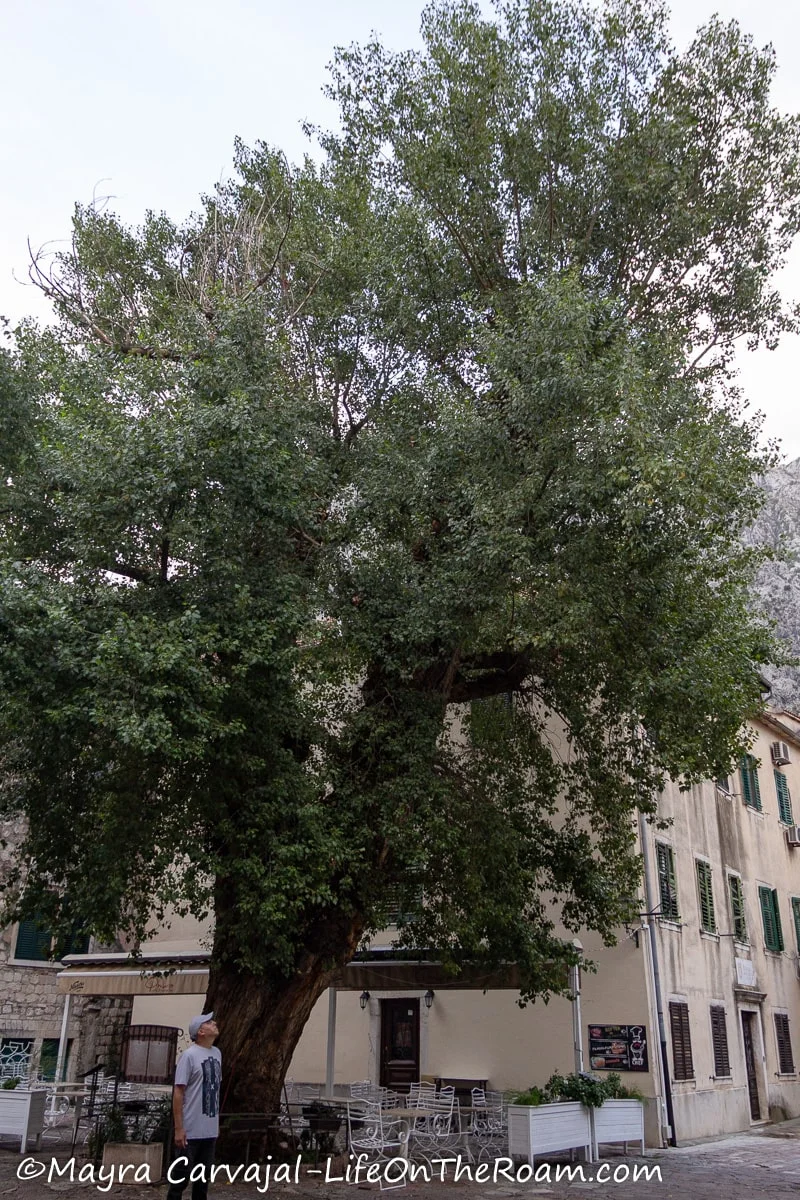
Today, it’s a landmark for the celebration of cultural events.
Franciscan Church of St. Claire
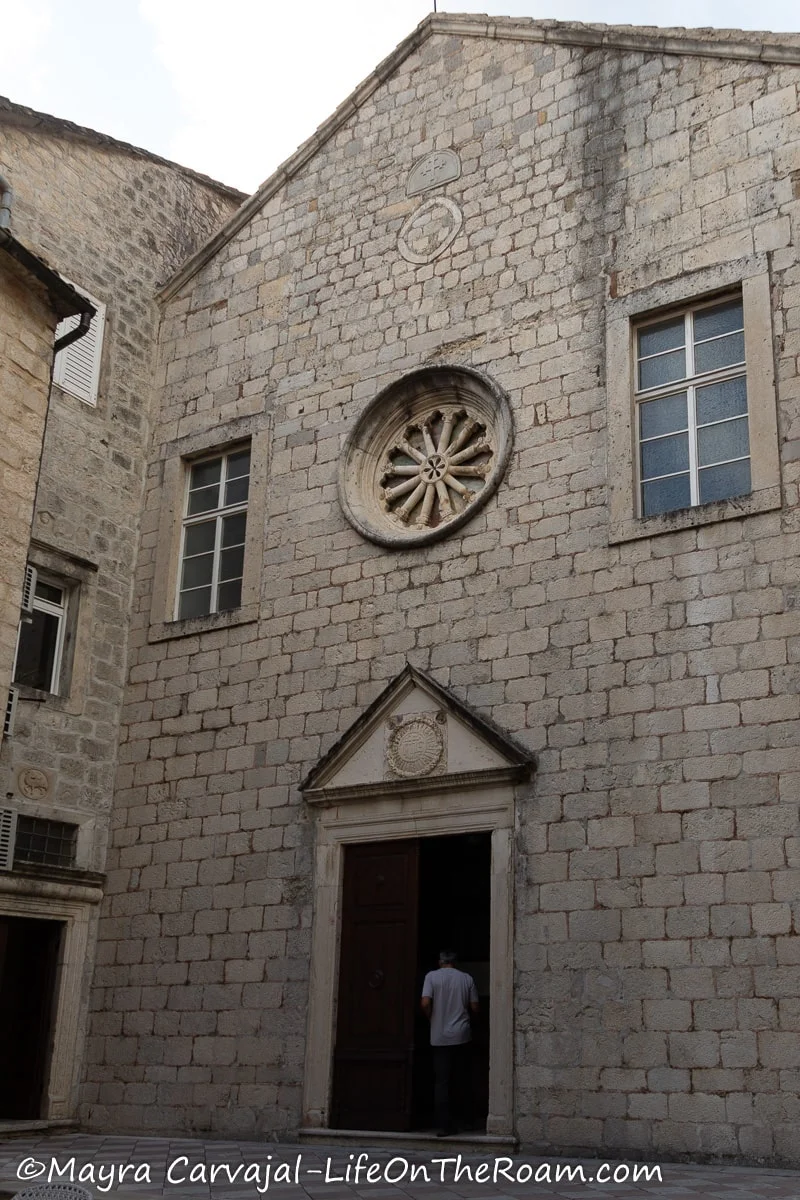
The focal point of this church, which underwent several reconstructions between the 14th and 17th century, is the big Baroque-style altar in red, white, gray, and dark beige marble. It’s a masterpiece completed in 1708 by Venetian sculptor Franceso Cabianca, full of angels and religious figures populating an elaborate structure with Corinthian columns, garlands, and more.


One of the most impressive features is the drapery held by two angels in the central panel, which from a distance you could swear is swirly fabric with a fringe trim, but it’s really marble.
The Maritime Museum (at the Grgurina Palace)
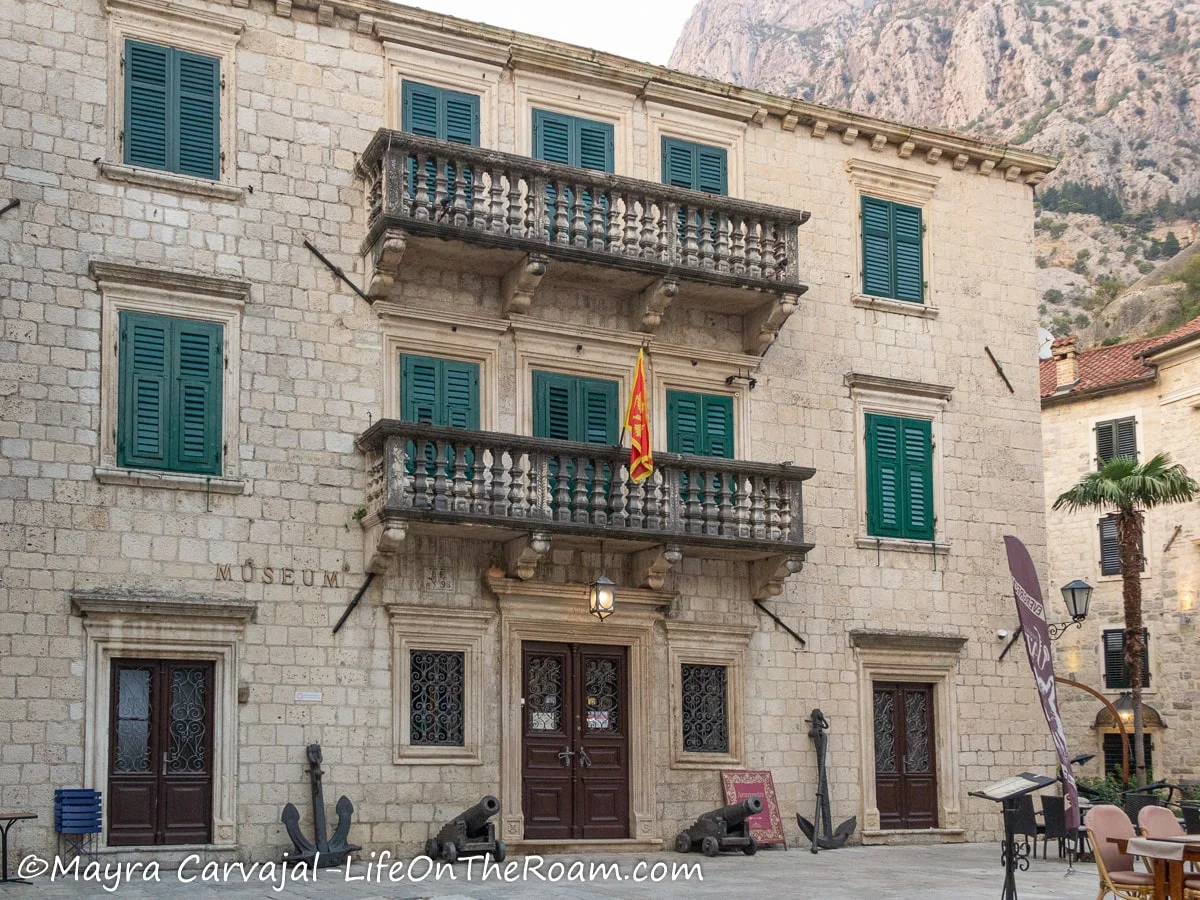
This is a great place to learn about the history of the Bay of Kotor which, as expected, is closely intertwined with the sea.
Inside this Baroque-style palace from the mid 18th century you’ll see great scale models and photographs of old ships, a vast collection of old weapons, navigation instruments, an exhibit from the two world wars, and historical documents.
There are rooms arranged with furniture and paintings from the 19th century which belonged to well-known families in the sailing scene, as well as an ethnographic collection with antique furniture, jewels, traditional costumes, and other items that reflect the evolution of the local culture.
General admission: €6 (includes an audio guide)
The Gallery of Solidarity (at the Pima Palace)
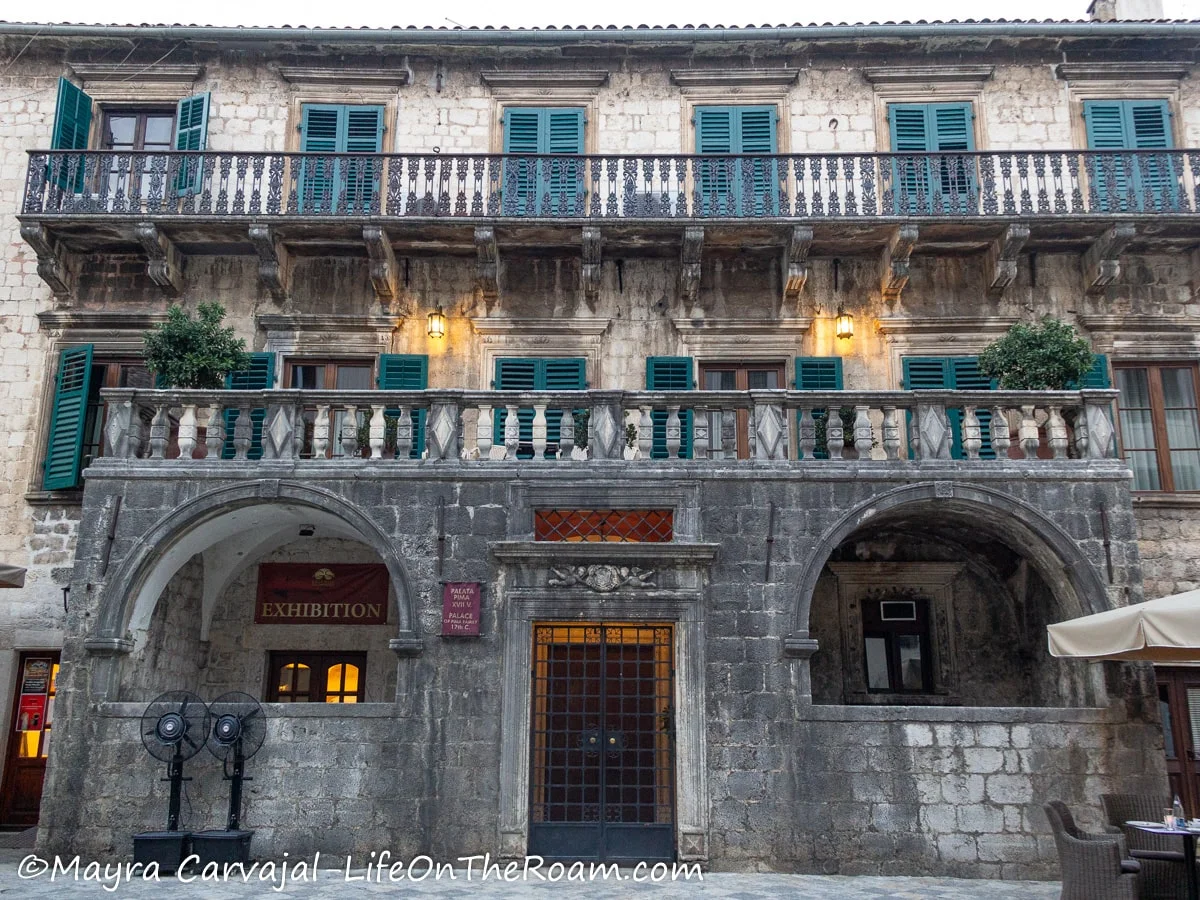
Come to the ground floor of the Pima Palace to see the work local artists produced during the Yugoslavia era in the 1970s.
Across the three small rooms you’ll see modern art paintings done with different media as well as some sculptures, drawings, and photographs.
The collection of roughly 400 pieces (you won’t see that many on display) keeps growing every year.
The venue is a 17th century Baroque-style palace in stone in serious need of some cleaning, with aquamarine shutters and two angels holding the Pima family coat of arms above what used to be the entrance in the portico.
Check out the beautiful wrought iron balustrade in the upper level balcony.
The Pima Palace is located at the Flour Square (Trg od brašna). The entrance is included in the combined ticket to visit the Lapidarium and the St. Paul’s Church.
The Palaces
Compared to other palaces in Europe the ones in Kotor are less impressive. These aren’t Royal palaces like Versailles or Buckingham, they’re residences of rich people that are referred to as “palaces”.
Even though they’re more subdued and that many details were lost during the 1667 and the 1979 earthquakes, that doesn’t mean that you won’t find some nice examples of Baroque and Gothic architecture and sometimes even curious details.
Some of them became museums, stores, and galleries.
As I strolled through the Old Town, these ones caught my attention:
Drago Palace

This building, located right across the St. Tryphon’s Cathedral, dates back to the Venetian period with work done between the 15th and 17th century.
The Drago family palace has some of the prettiest restored windows in Kotor, with Gothic-style pointed arches and quatrefoils on the upper window and corbels shaped like a lion’s head on the lower window.
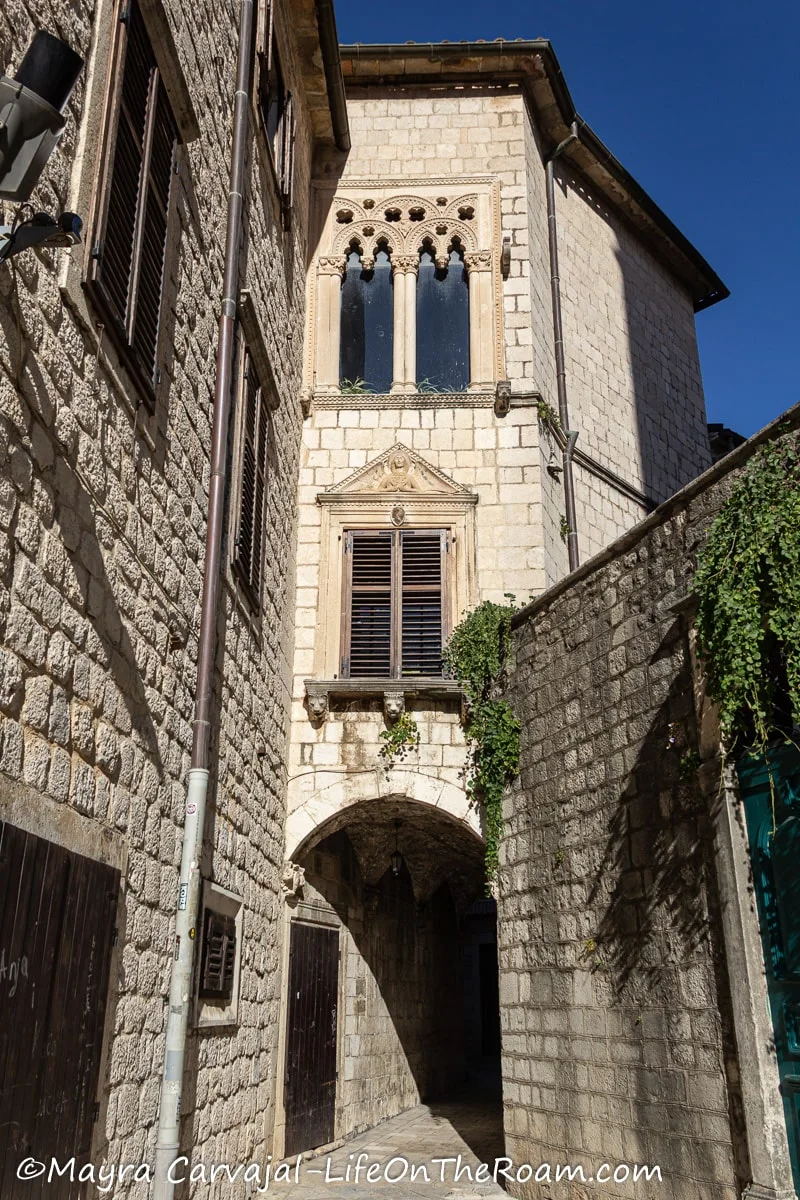

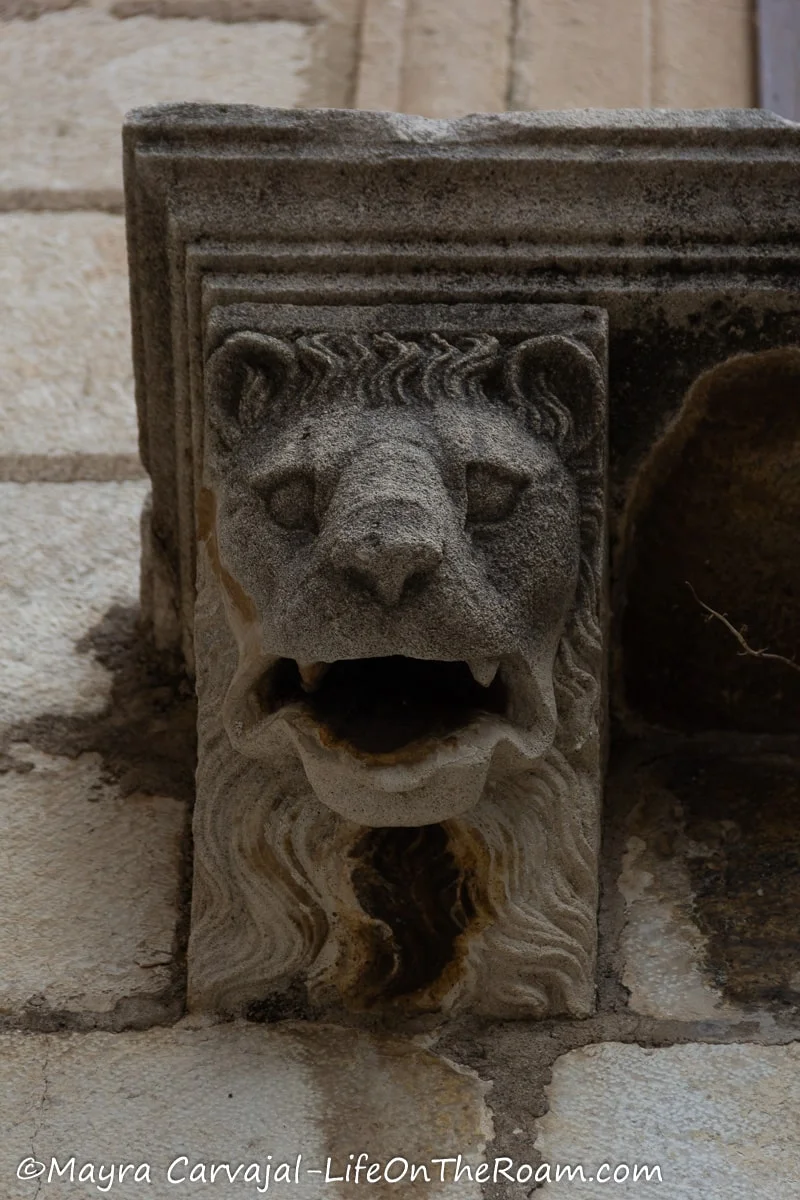
The upper section of both windows have a small piece depicting a dragon, the coat of arms of the family. To see it closer, walk towards the covered alleyway to find the dragon on some of the original Corinthian capitals.


Grubonja Palace

Grubonja Palace was built in 1326 and it was first occupied by a pharmacy before becoming a residence in the 17th century.
It looks pretty much like all the buildings around, but if you look harder you’ll catch a unique detail: a carved skull with snakes (a reference from its pharmacy era), a turtle, cross bones and what looks like a rodent.
To the left, you’ll find the arch crowning the street that leads to the trail ending at the Kotor fortress.
Beskuća Palace
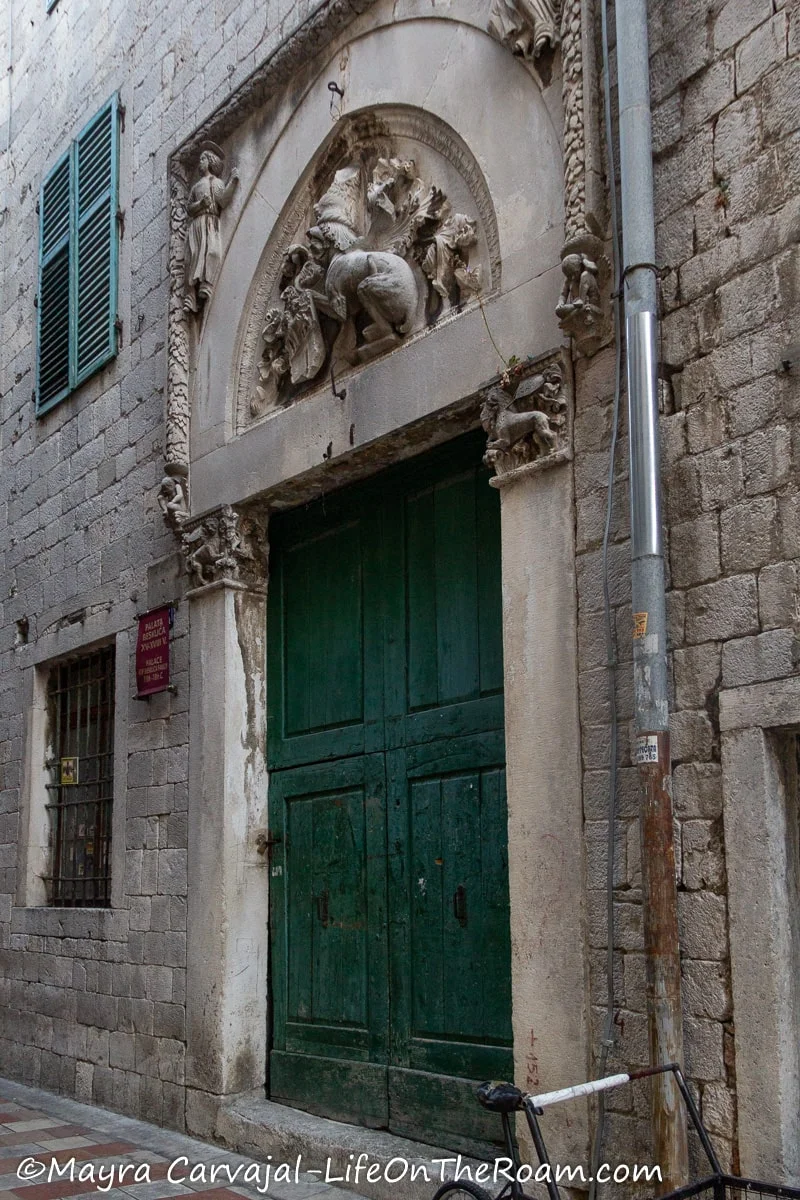
The Beskuća Palace was built in the 15th century and then remodeled up to the 18th century, with many cool details around the entrance. You can easily spend several minutes checking out the many carvings decorating the capitals and the tympanum.
In the front of the Corinthian capitals you can see a lion carrying a coat of arms around the neck. It looks like there’s another big cat on the side, clutching a small animal with its claws.
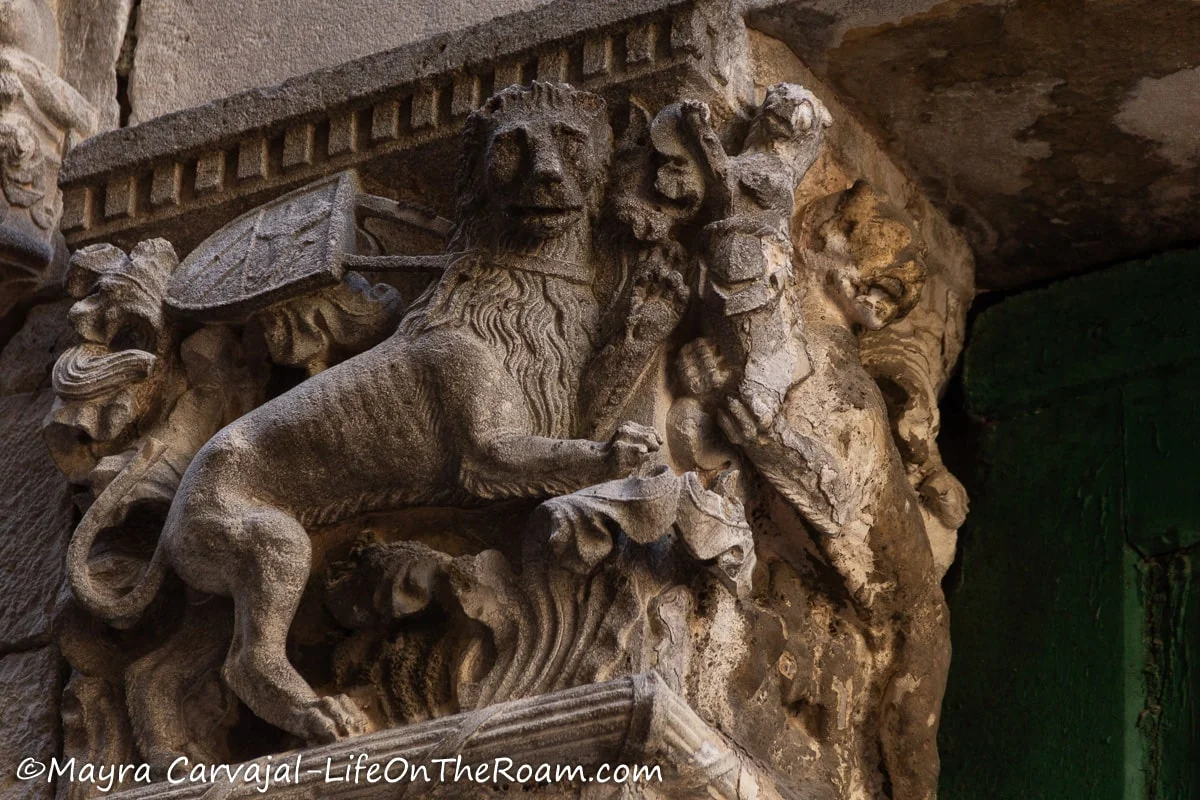
Around the tympanum there’s a rectangular frame with vines on three sides. The child-like figures in the lower corners look to me like cherubims that lost their wings at some point.
Inside the frame, in the arched section with the leafy border, there’s a winged lion with a helmet holding a coat of arms surrounded by many swirls. Two angels guard the entrance in the upper corners.
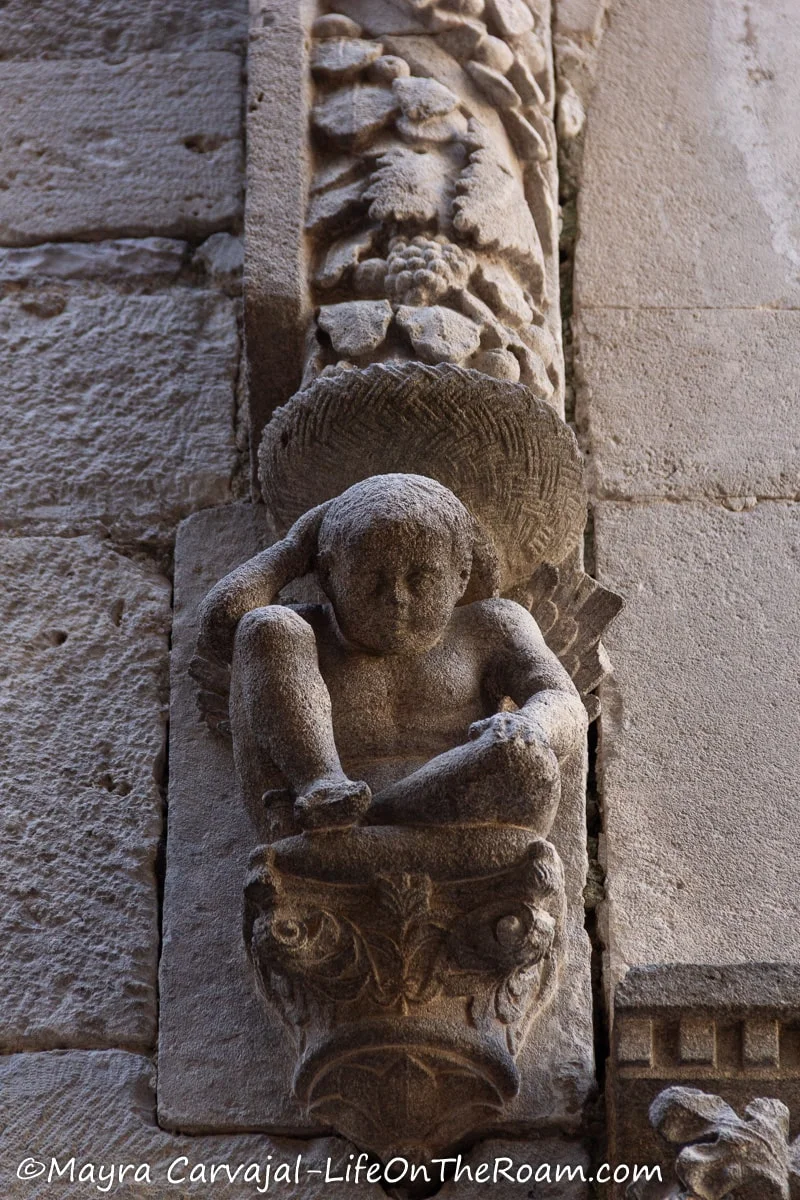
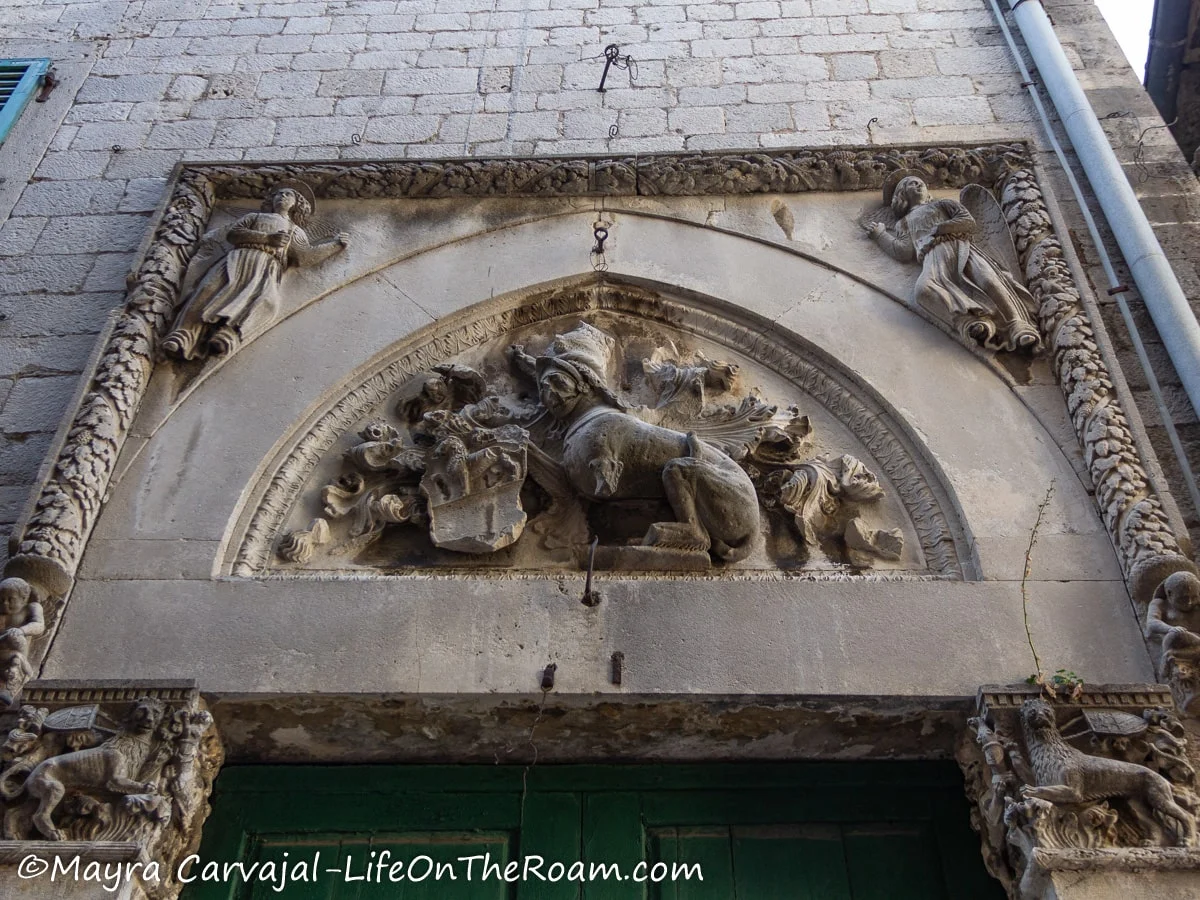
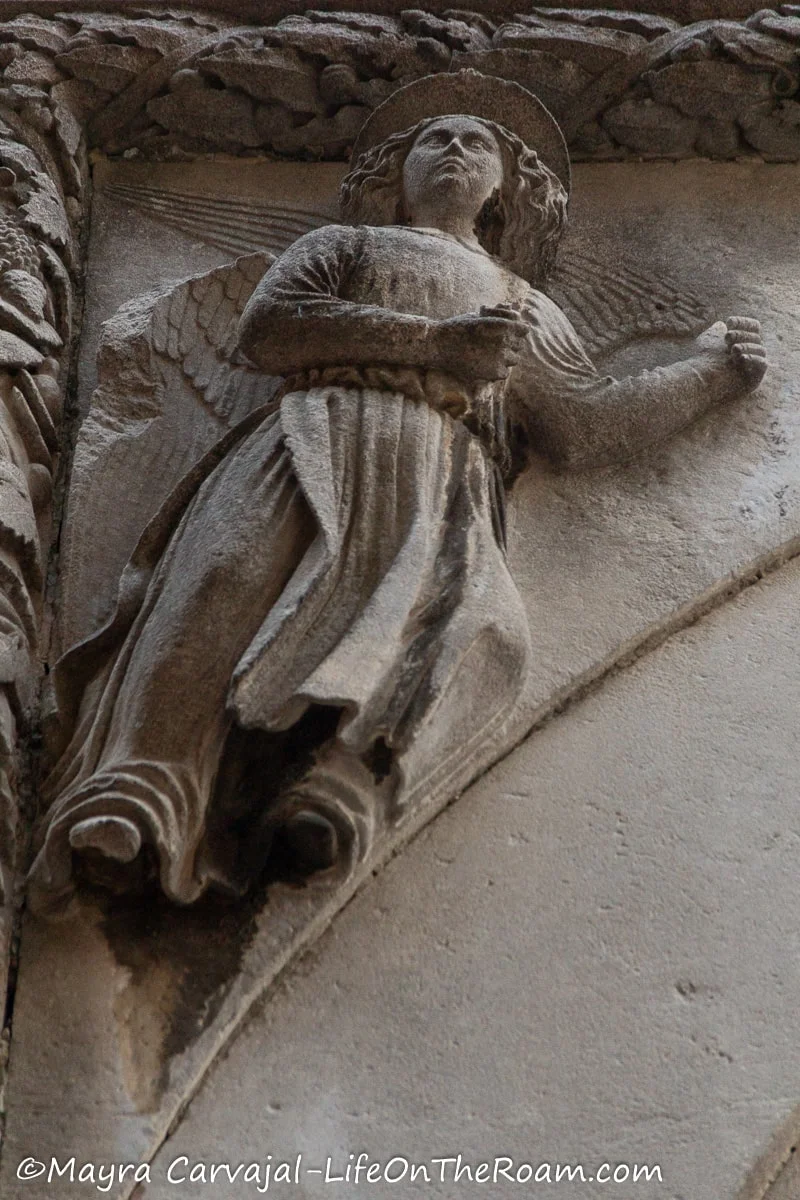
Some chunks are missing, but I think this Gothic-style ornamentation is worth a stop during your walk around Old Town.
Try Marshall’s Gelato
I love gelato and I must say that Marshall’s is in the top five gelatos I’ve tried anywhere. This is way better than your regular “good” commercial gelato. They do small batches and use natural, high-quality ingredients that leave no aftertaste.
Take a break from your walk around town to try this deliciousness.
Where to Stay in Old Town Kotor
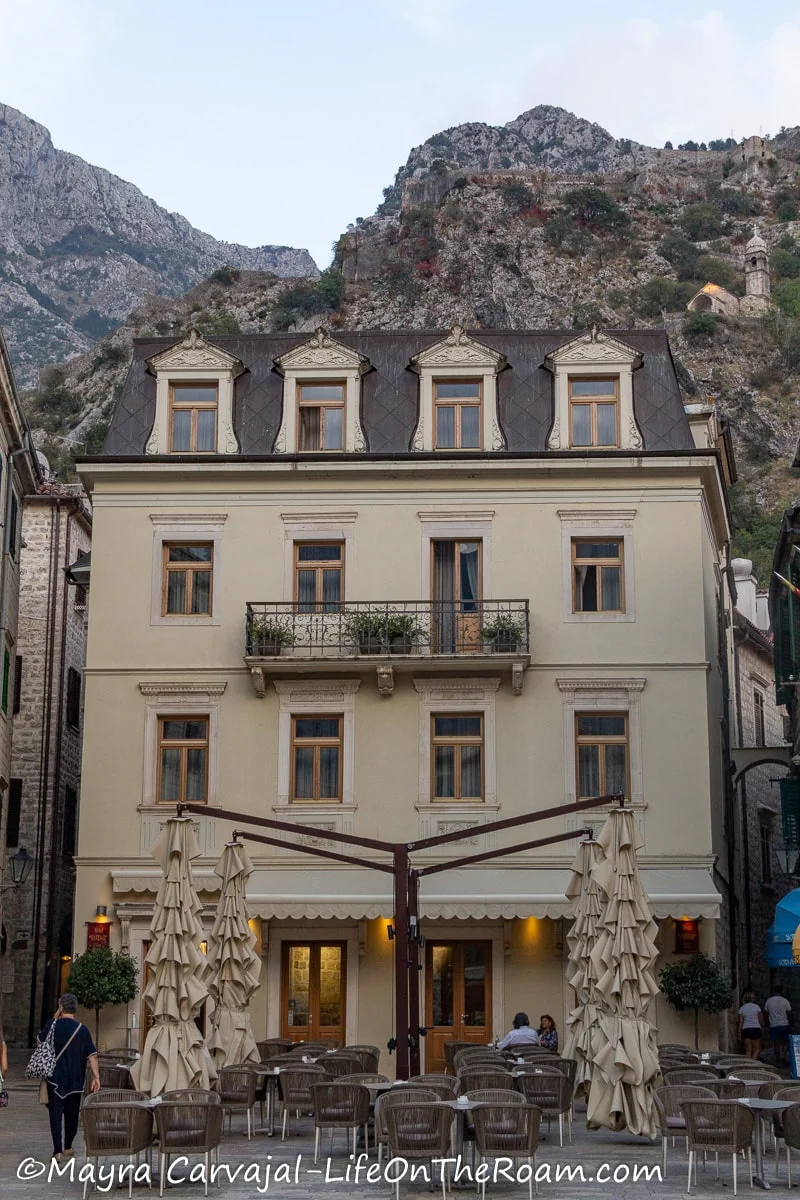
Staying inside the Old Town is fun and convenient, but be aware that it can be noisy as there are bars and nightclubs playing music until 1AM. Some multi story units don’t have elevators so you must be fine taking the stairs.
Here are some good options at different price points:
HOTEL VARDAR: an elegant early 20th century building houses this 4-star hotel (with elevator). Rooms have AC, flat-screen TV, a mini bar, a desk and a sitting area. Breakfast buffet included.
Stay at Vardar, with a rating of 9.1/10 based on more than 865 reviews.
ROYAL HOUSE: these apartments come with a kitchenette and mini fridge, a sitting area, AC, and even a washing machine. Parking included.
Stay in this apartment, with a rating of 9.1/10 based on more than 565 reviews.
CENTRUM HOSTEL: you can book a basic private room with AC (with shared bathroom) at this hostel that offers a shared kitchen and great views of St. Nicholas and St. Luke Churches.
Book your stay here, with a rating of 9.3/10 based on more than 825 reviews.
Best Time to Visit Old Town Kotor
If you can’t schedule your trip during late spring or early fall to avoid the summer rush, try to visit on days where there are no cruise ships on port for a more relaxed experience.
Otherwise, arrive early morning to beat the crowds.
How to Get to Old Town Kotor
By Car
Road E65/E80 passes right in front of the Sea Gate and goes all along the shore of the Bay of Kotor. It’s the same Adriatic Highway (Jadranska Magistrala) that crosses from Croatia into Herceg Novi.
Take the word “highway” with a grain of salt. It’s a scenic, two-way road on the narrow side with a lot of curves.
The Old Town is 100% pedestrianized so you must find a spot outside in one of the parking lots in the area, which can be hard to do if you’re visiting during the high season.
If you’re staying in Kotor check if your accommodation already includes parking.
Check car rental rates and availability with Rental Cars
By Bus
You can reach the (very sad) Kotor bus station by public bus from the most popular destinations in Montenegro.
From Budva: 30 minutes to one hour
From Bar: 1.75-2.25 hours
From Cetinje: around 1.5 hours
From Ulcinj: 2.5 hours
From Tivat: 15-30 mins
From Herceg Novi: around 1 hour
From Podgorica: about 2.25 hours
For prices and schedules check www.busticket4.me
Departing from Kotor, to the ticket prices you must add a couple of euros to pay for a “bus station fee” (??!!??), a printing ticket fee (the digital one isn’t accepted as if we would be in the middle ages), and a luggage fee. Cash only.
By Boat
If you don’t want to deal with traffic, a way more expensive option is to hire a water taxi that takes you to and from other towns in the Bay of Kotor.
Kotor is also a popular cruise ship destination along the Adriatic Sea. If you arrive on a cruise, tender boats will drop you just steps away from the Sea Gate.
By Air
The closest airport to Kotor is the Tivat International Airport (TIV). It’s only 15 minutes away by car.
There are less flights landing in Tivat and they’re generally more expensive. You can also fly into the Podgorica International Airport (TGD), which is about 2 hours away by car.
With ancient churches, interesting architectural details, and a fun vibe filling the walled town, it’s no surprise that this UNESCO site is the most visited in all Montenegro.
Want to visit another vibrant walled town nearby? Check out the Old Town of Budva, less than an hour away.
BOOKING FLIGHTS AND ACCOMMODATIONS
Book your flight without losing your shirt
We check Momondo to find great deals to book our flights. Also, check Great Escape: it combines the listings from Expedia, Kiwi, Kayak, (and Skyscanner on the premium service) to find the best airfares.
To find a place to stay for less
Booking.com: this site combines everything under the sun. You’ll find hotels, apartments, B&B, hostels, rooms, etc., with all sort of filters to make your search a breeze.
Hotwire: the first site I check when we plan to stay at a hotel for a few nights. You can save anything from 20% to 60%. Use the search filter to find what you want and you’ll end up with three listings that match your criteria. You’ll know which one you’ll get after you book. If you can handle a little bit of uncertainty you can score big savings.
House Sitting: you take care of people’s pets and house for free while staying for free. It’s the closest thing to experiencing a place “like a local”. But it comes with responsibilities… Are you an animal lover? It may become your new way to travel.
To get travel insurance
SafetyWing: travel medical insurance that gives us peace of mind knowing that we’re covered in case of emergency. It’s convenient, affordable, and suitable for digital nomads who spend a long time outside their home country.
Check the full list of travel resources on my Resource Page for more options and savings